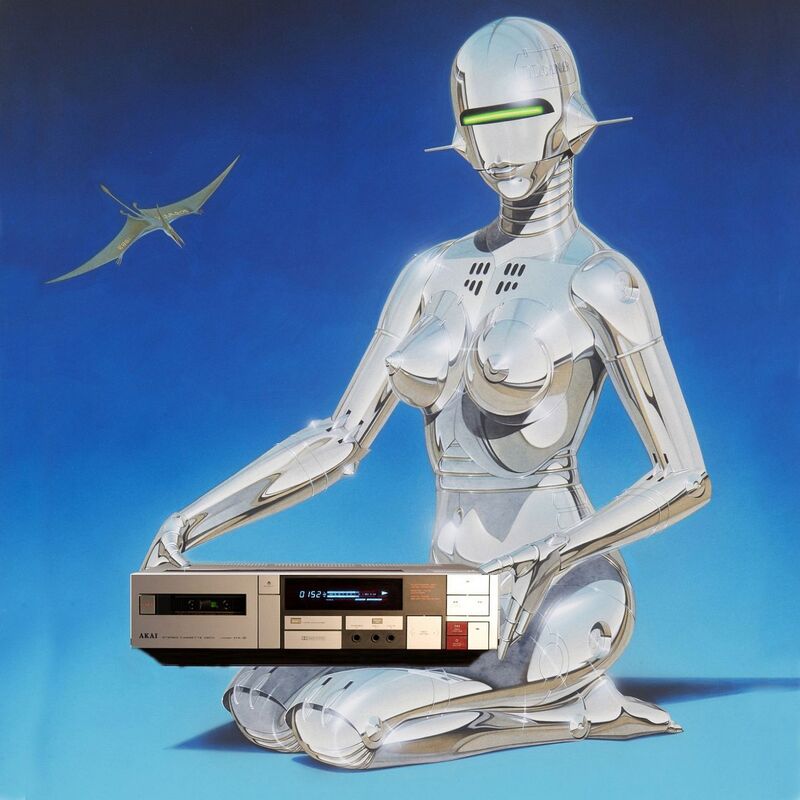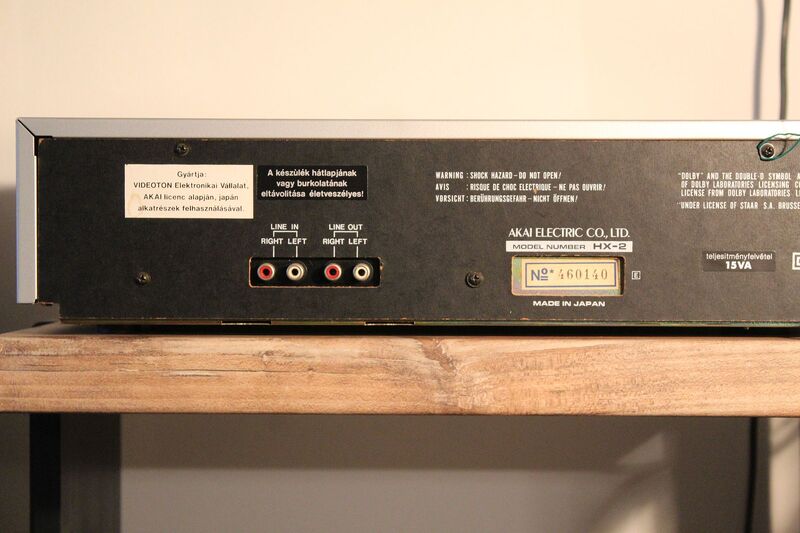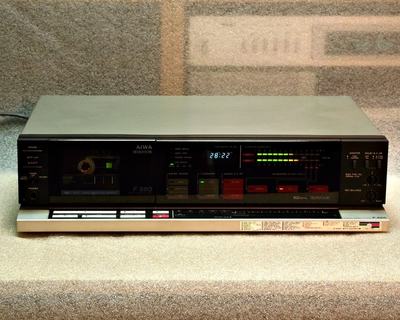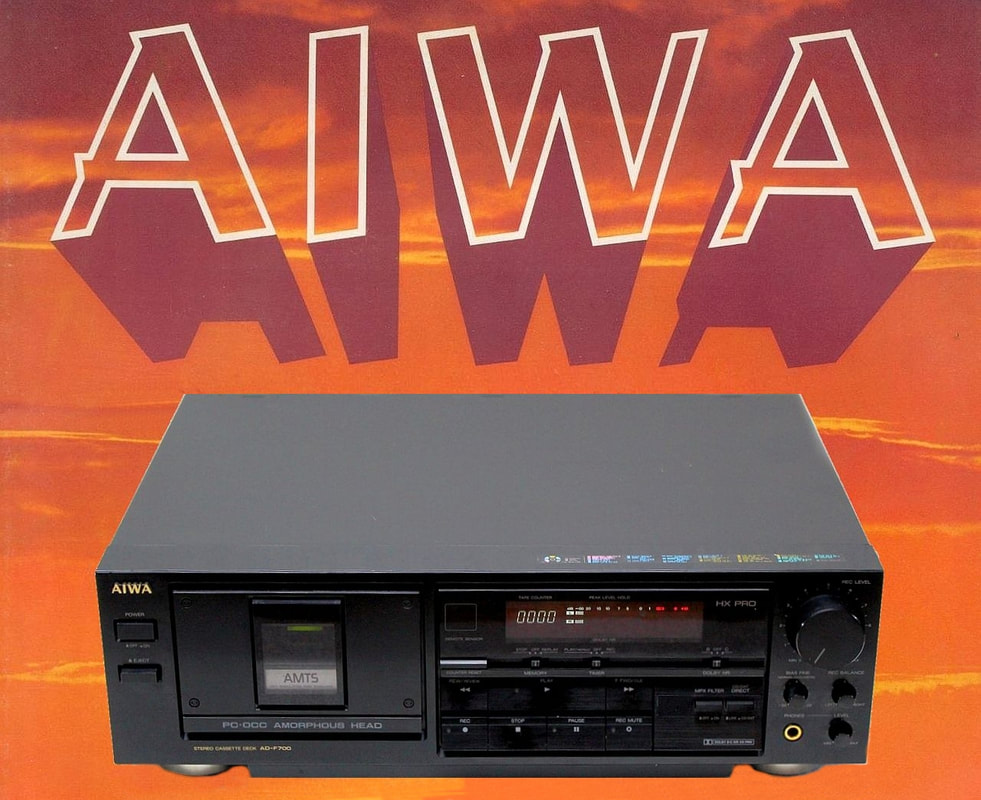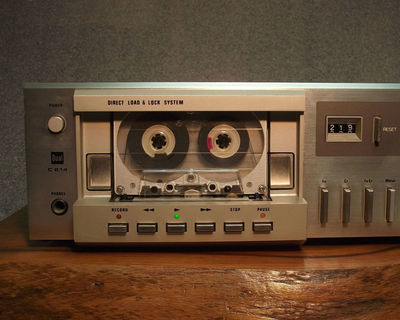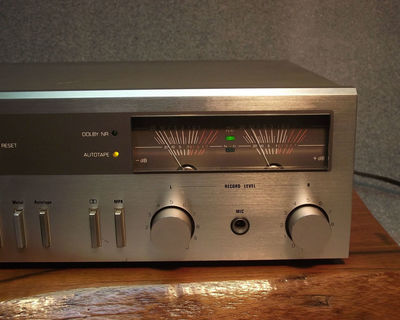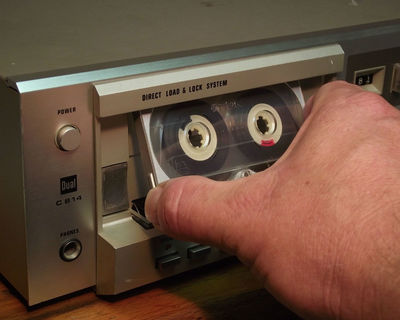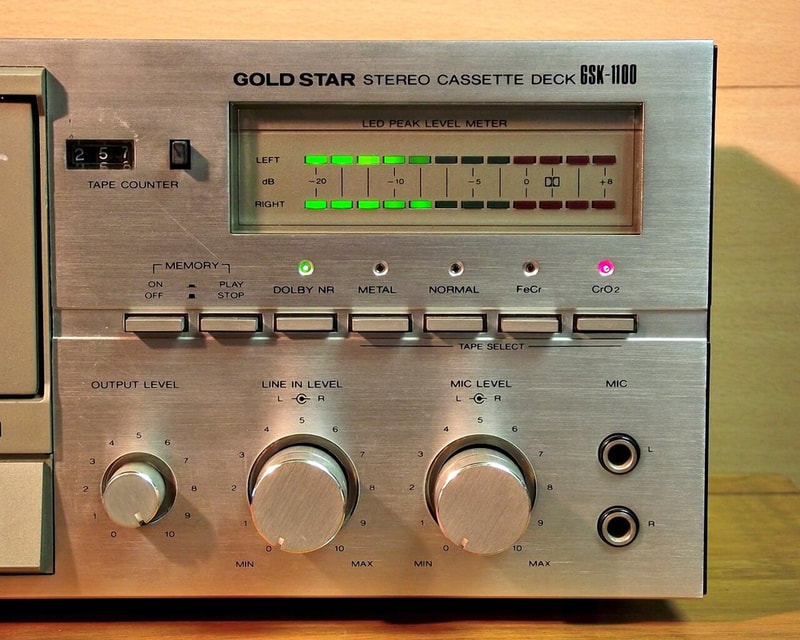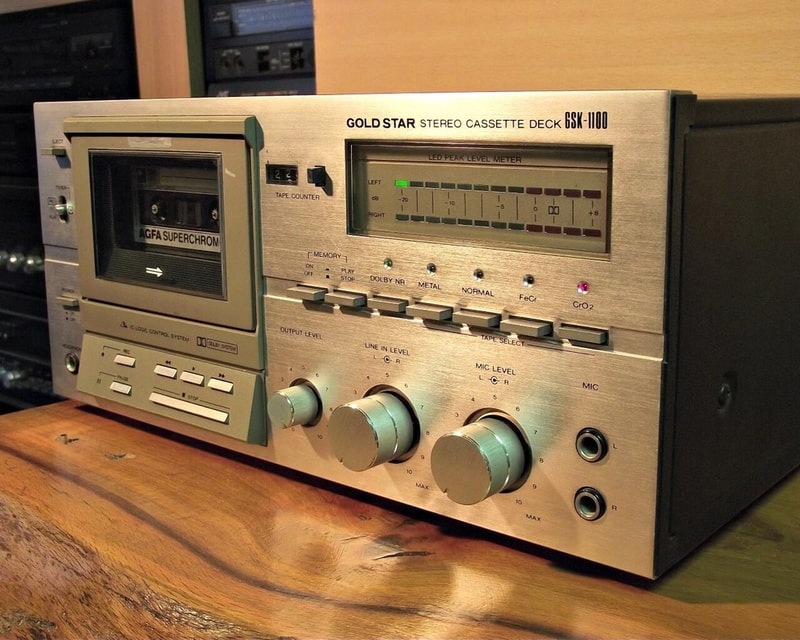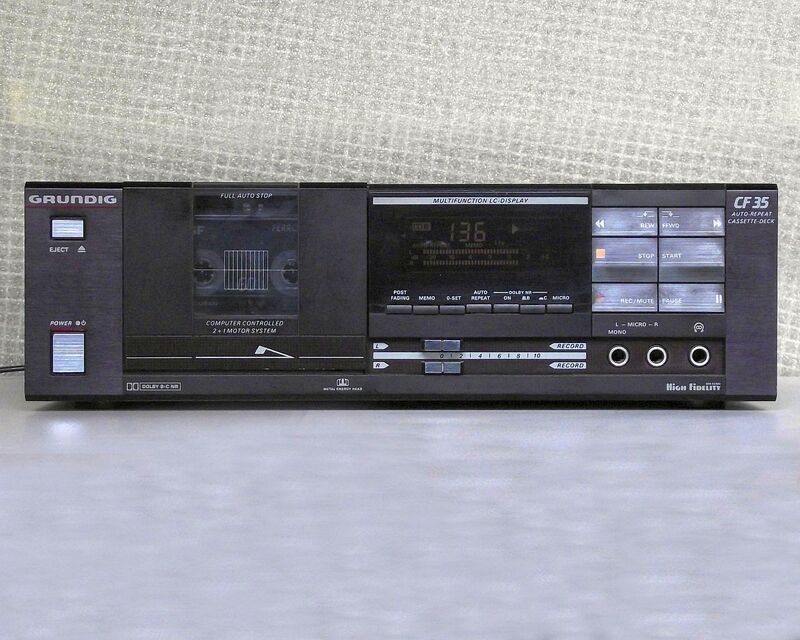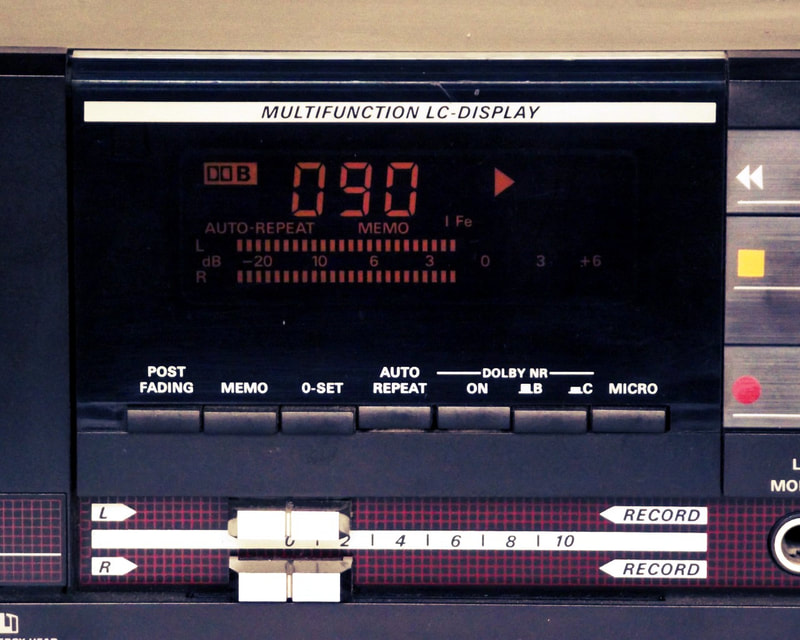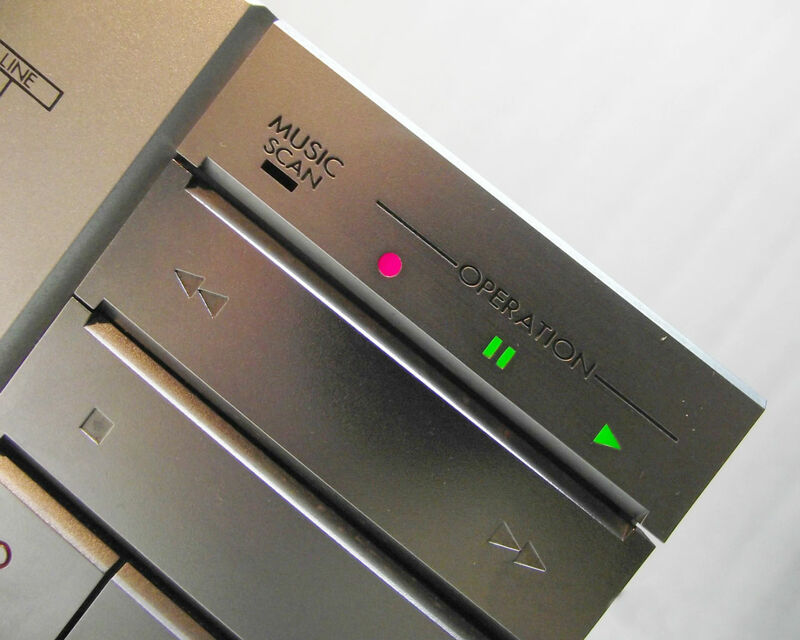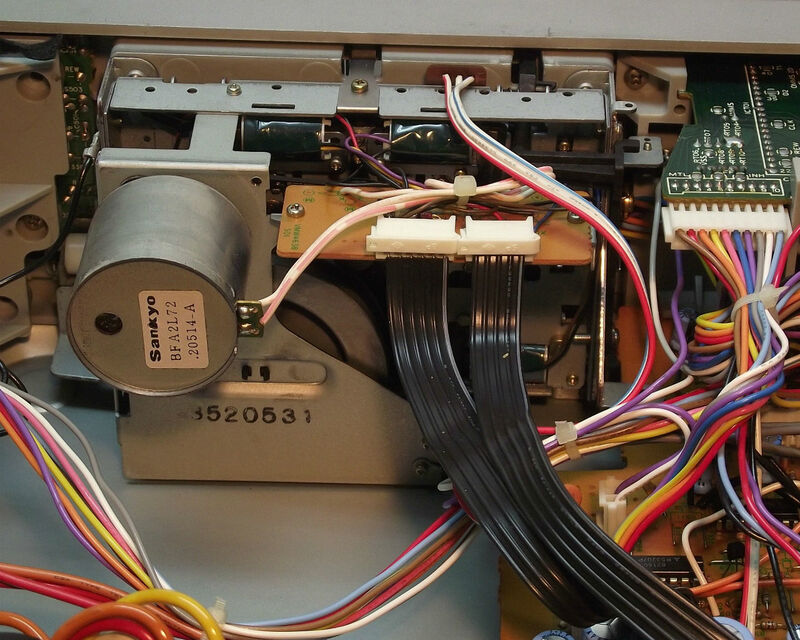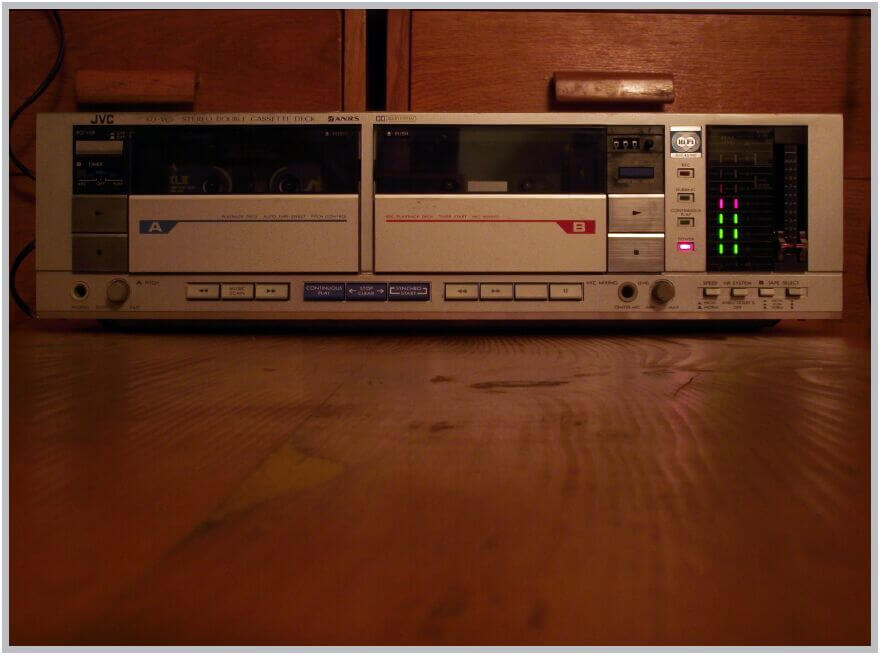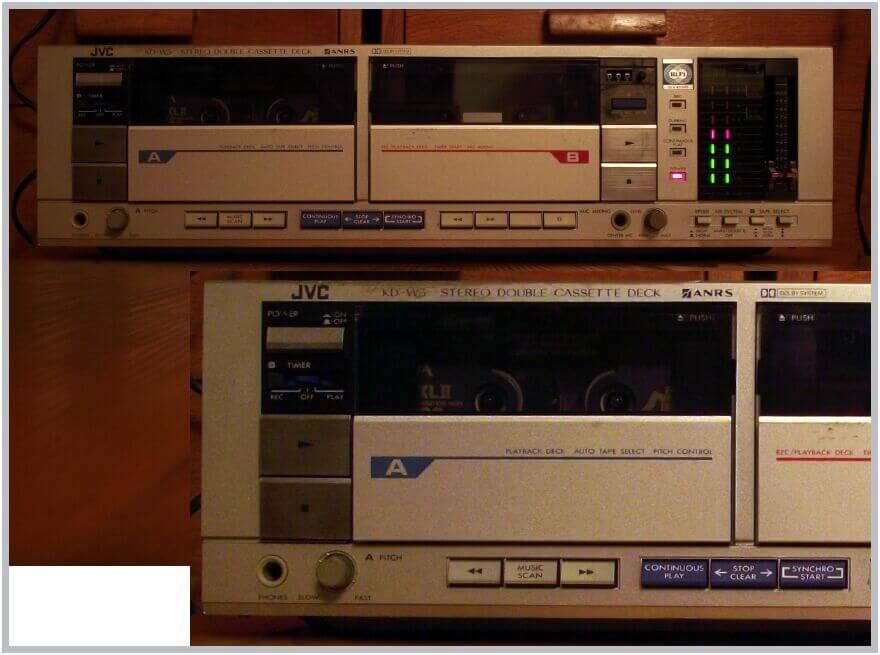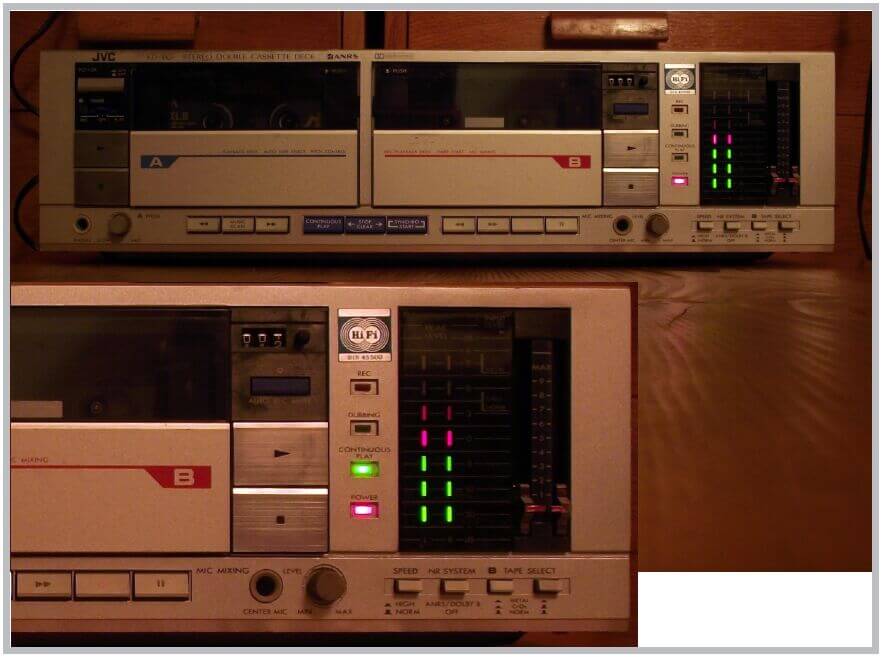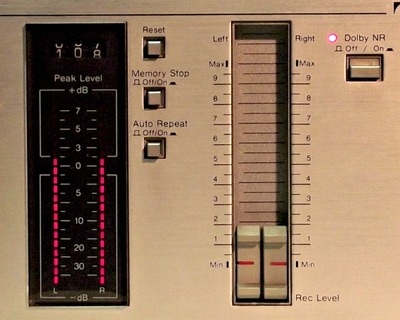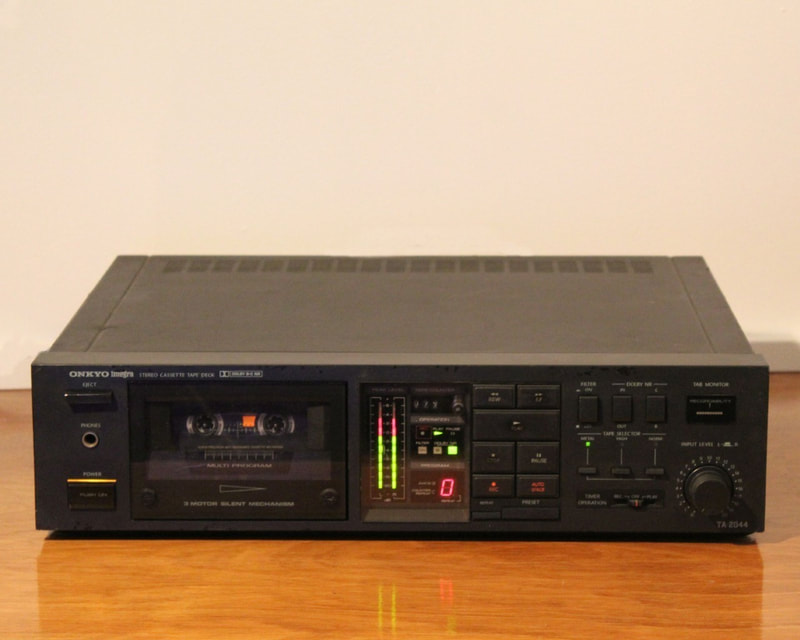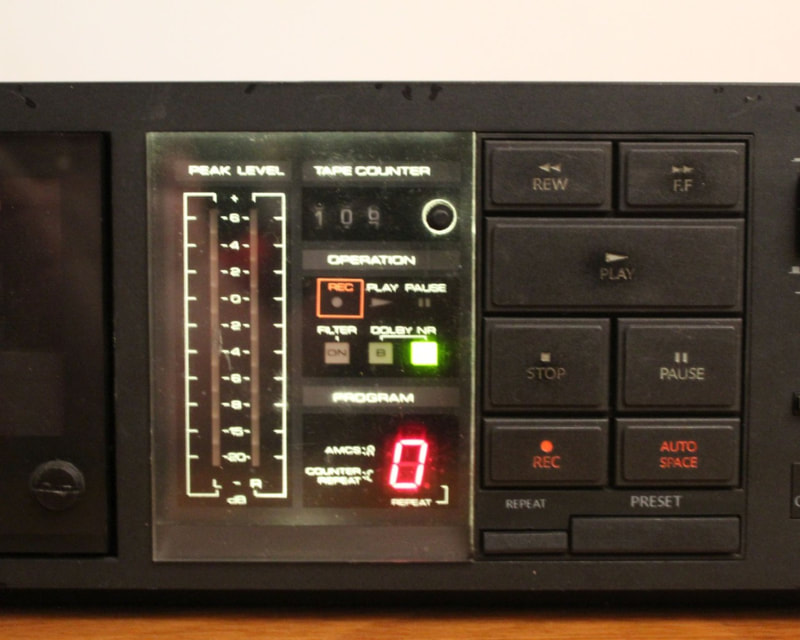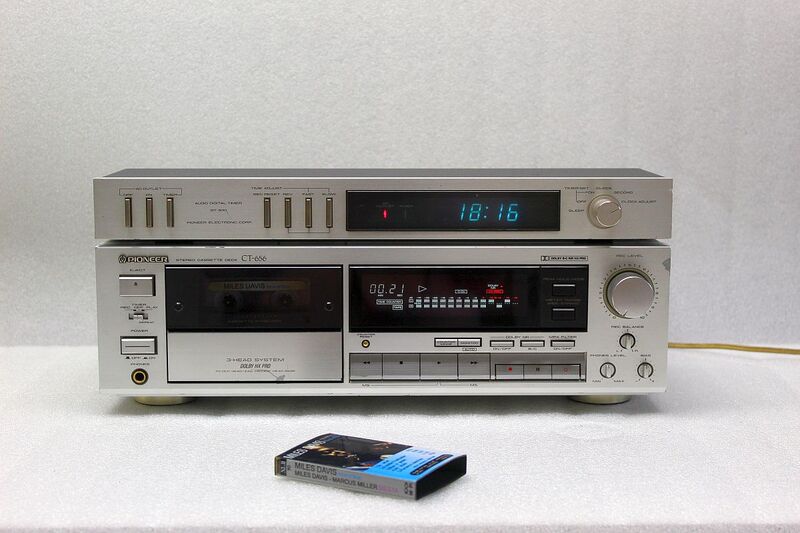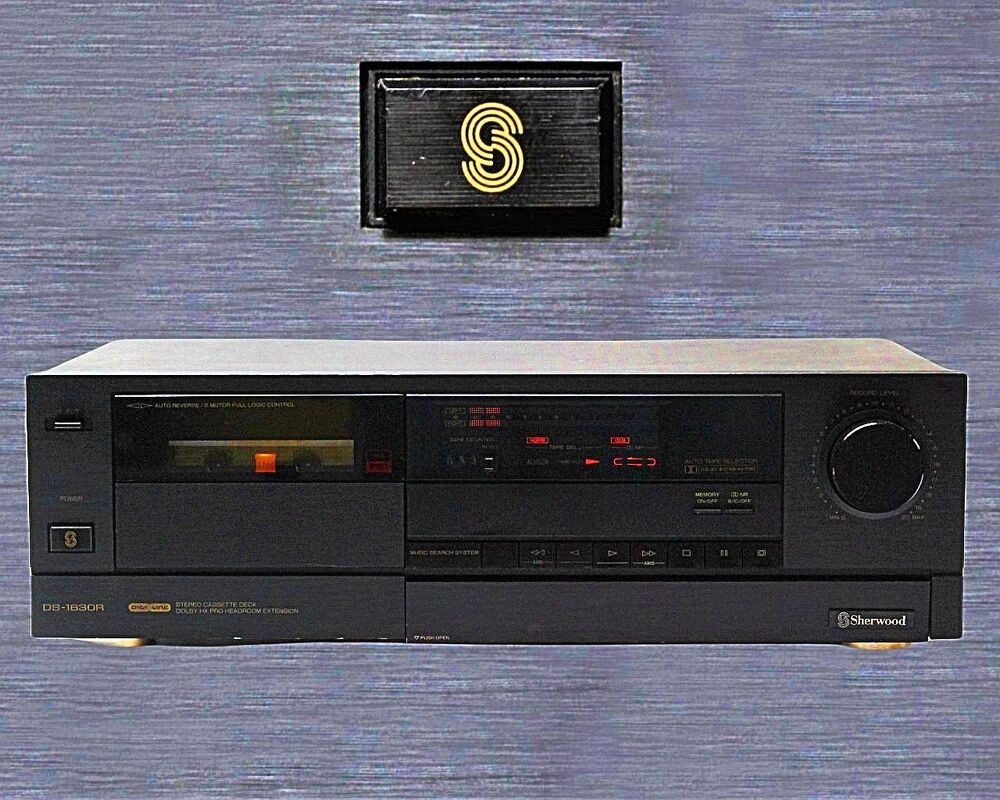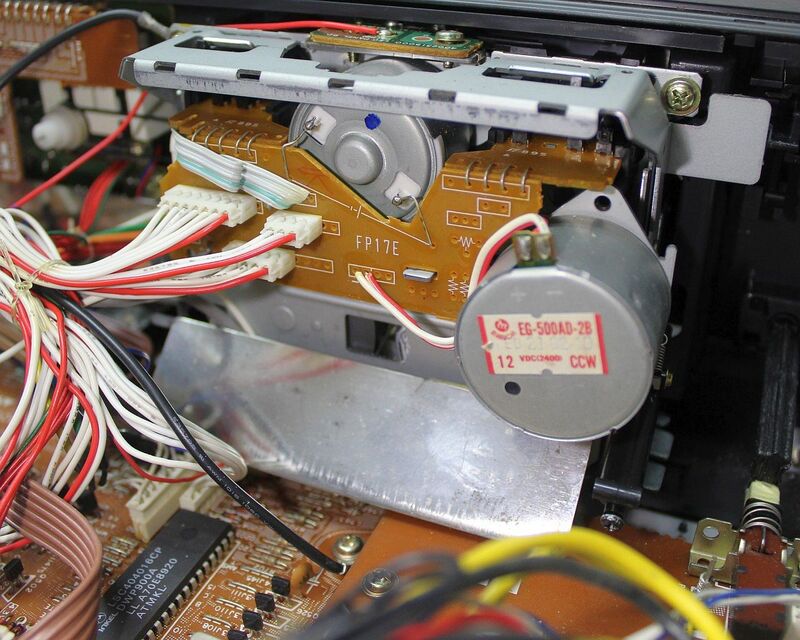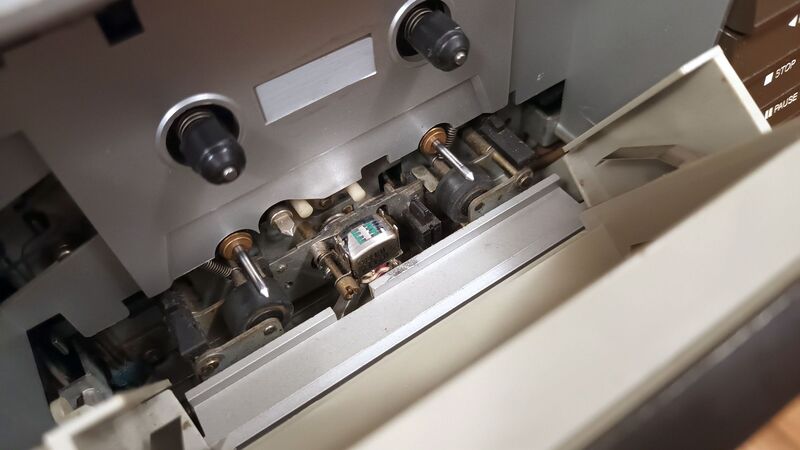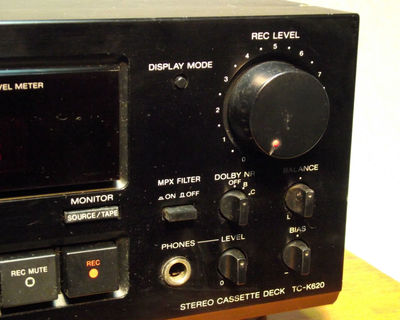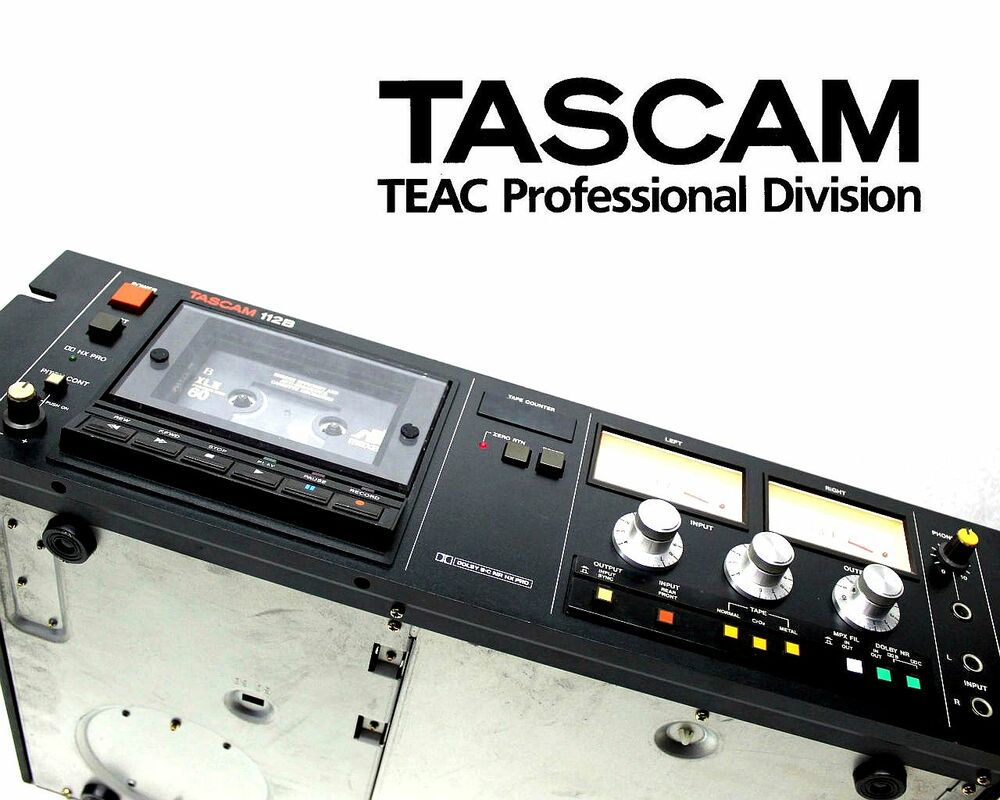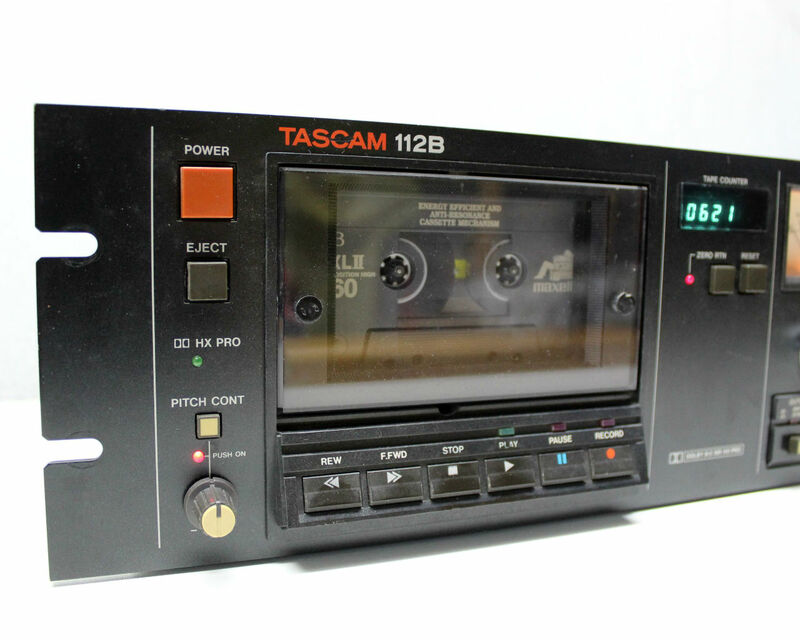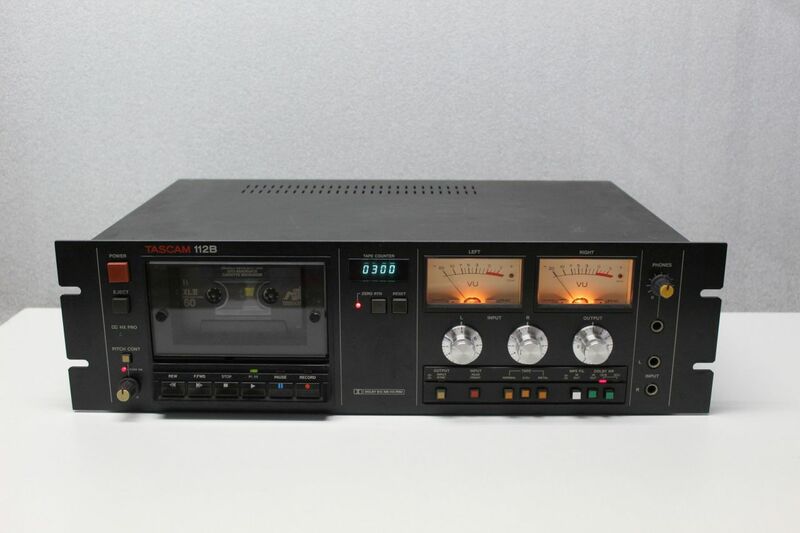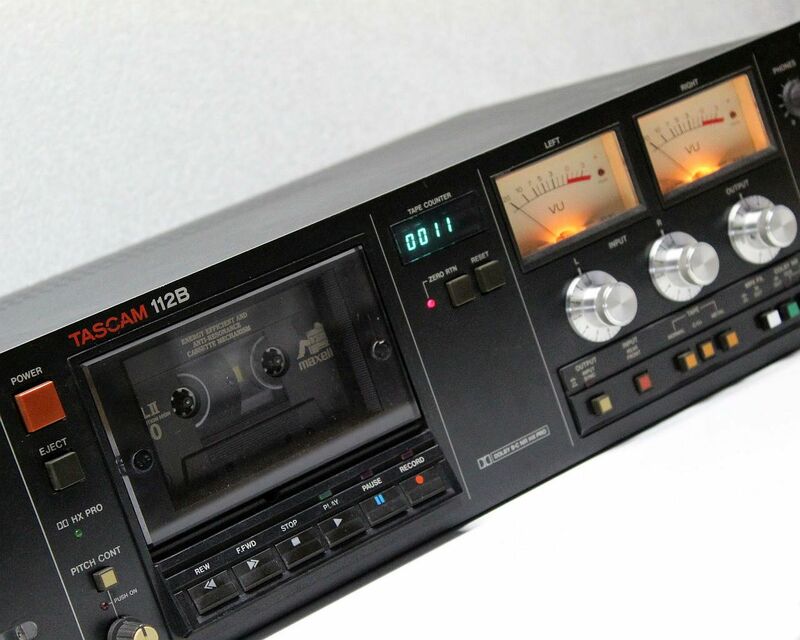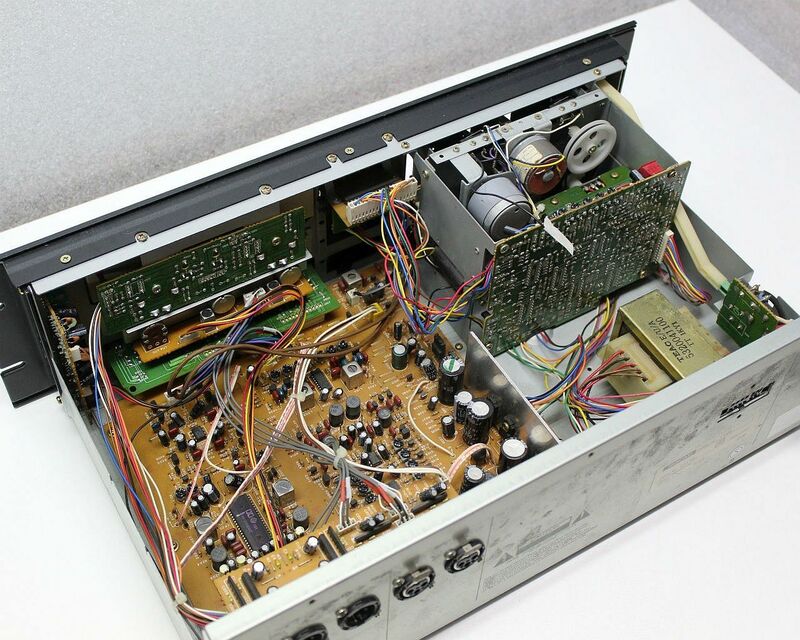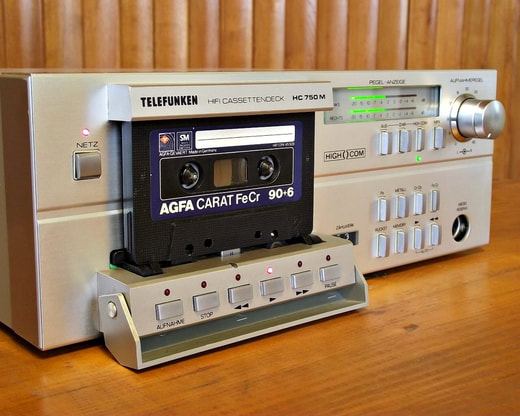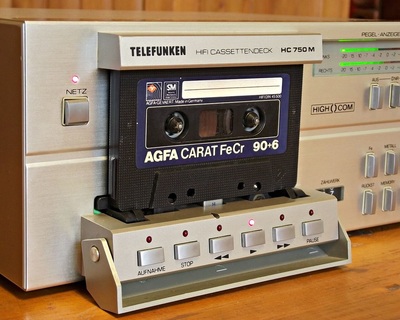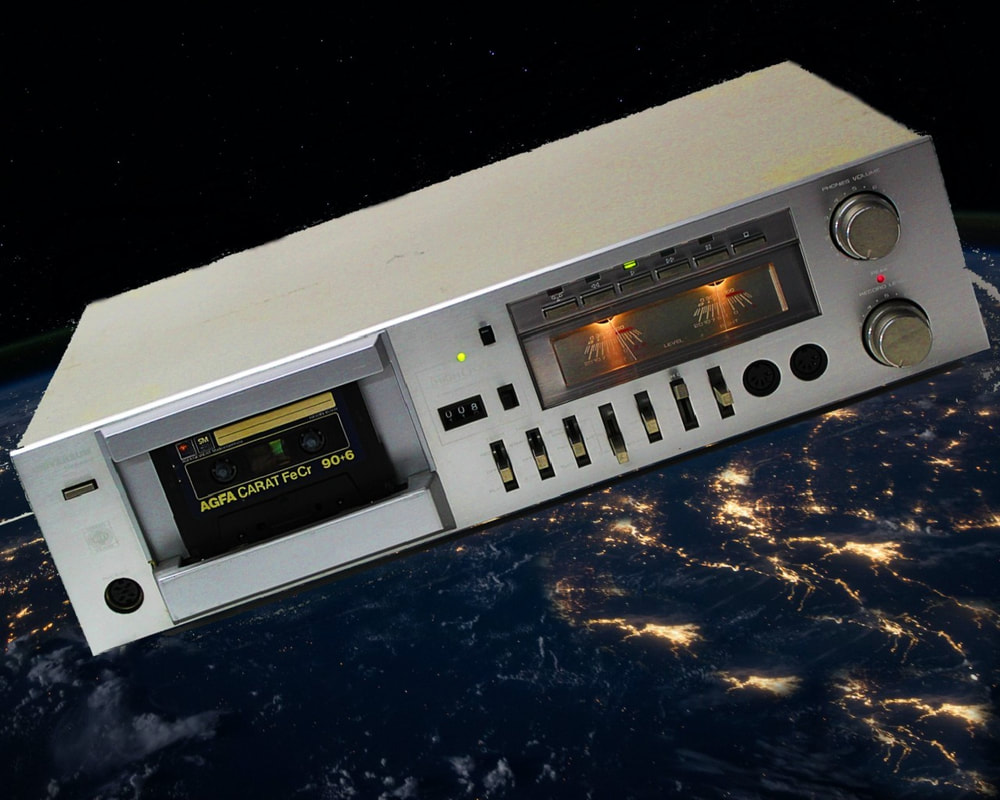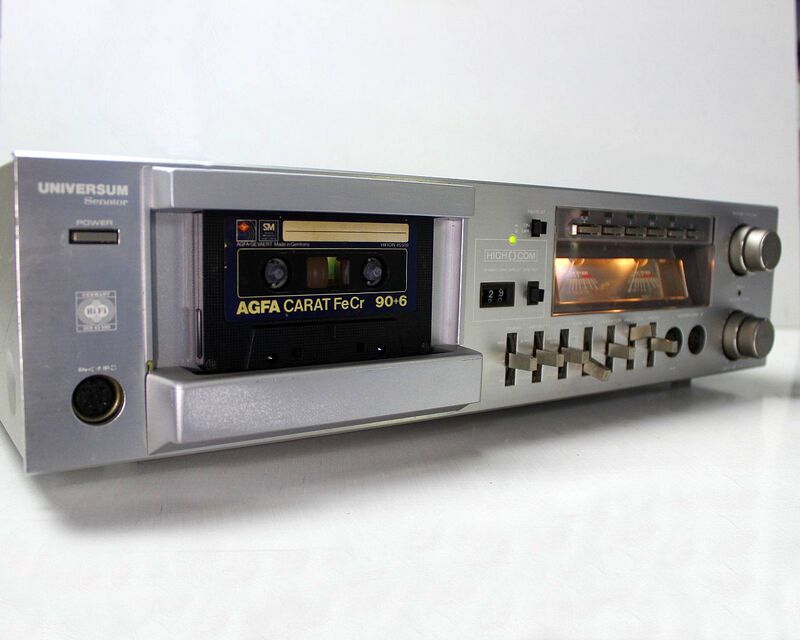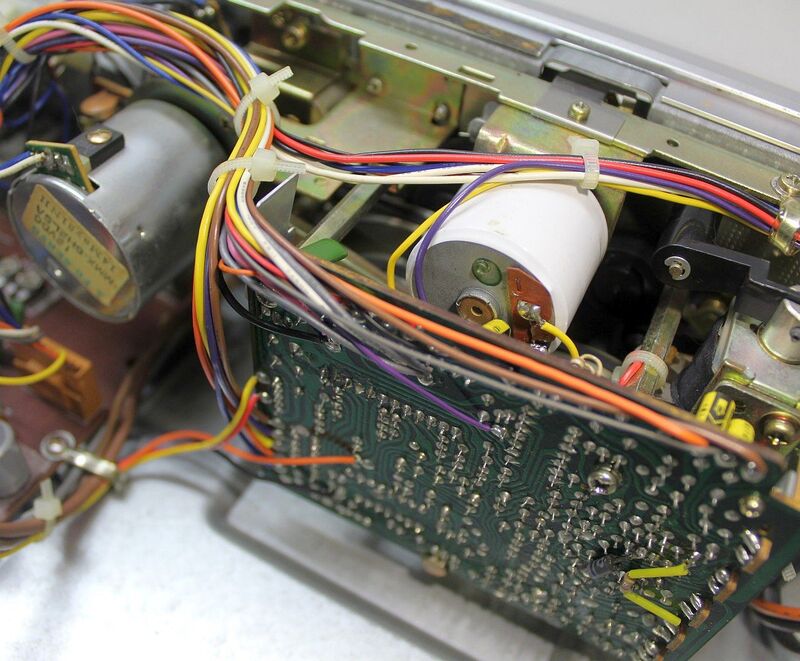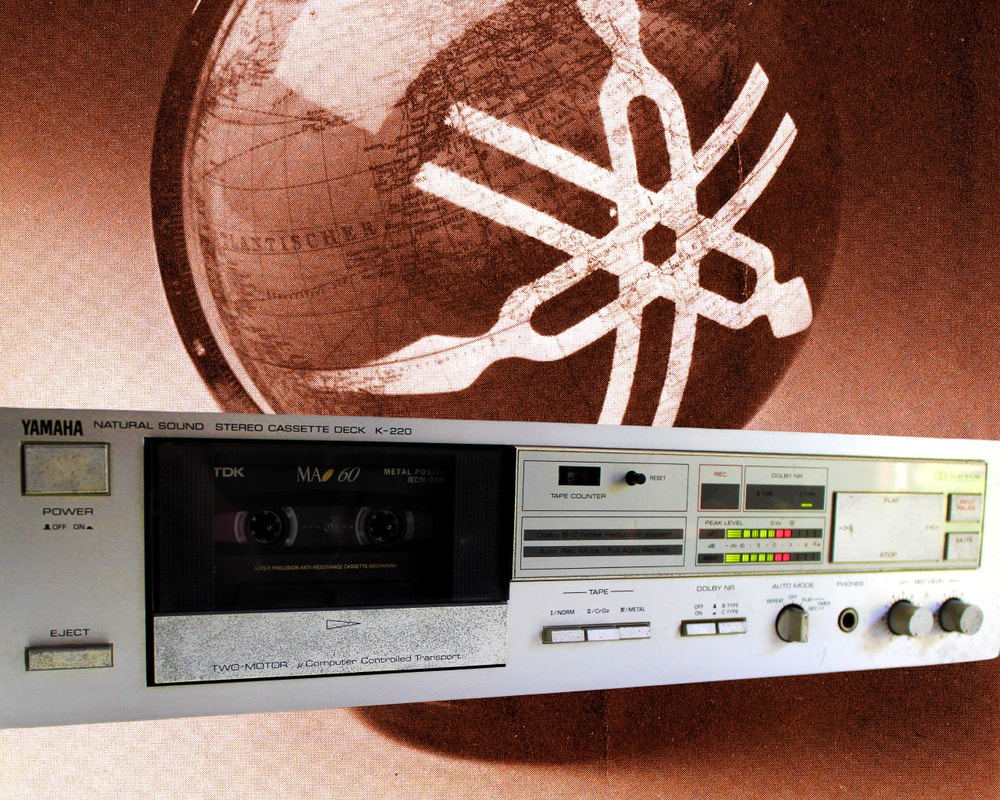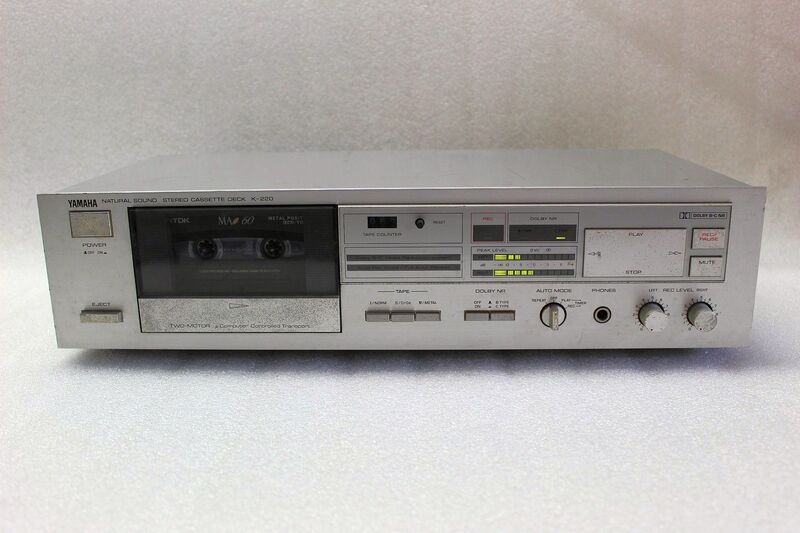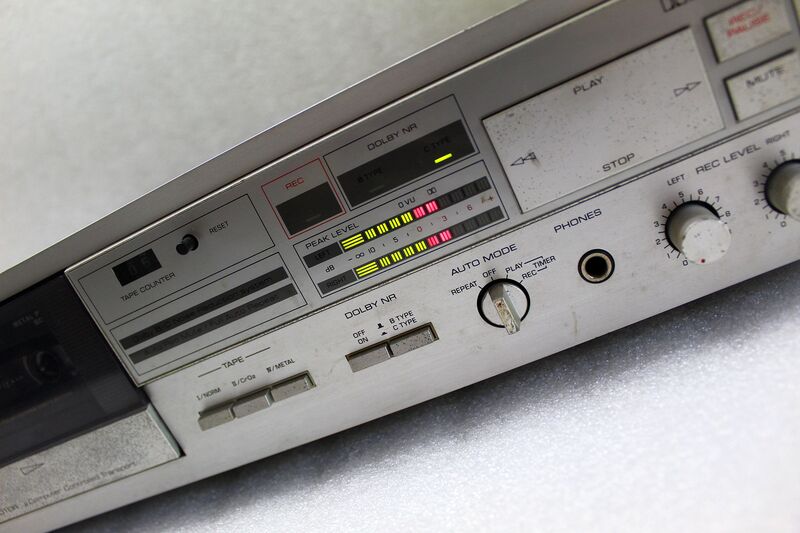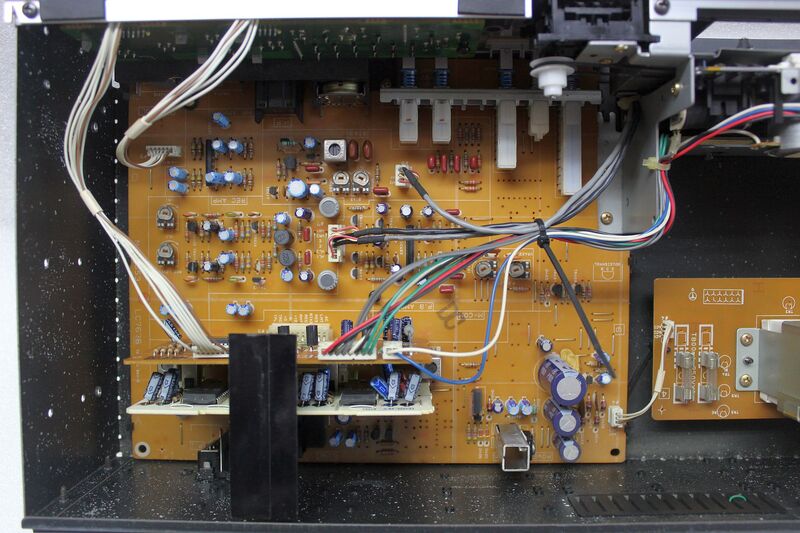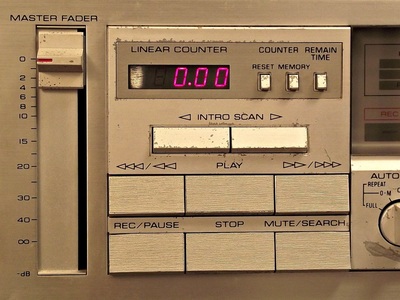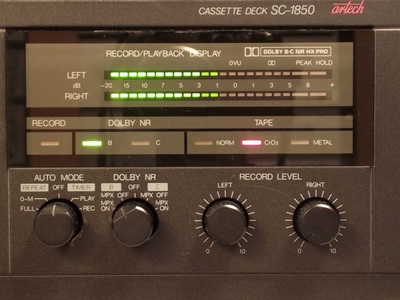CASSETTE DECK 1981 - 1990
The 1001 Hi-Fi Collection
AKAI GX-F31 (1982)
The AKAI GX-F31 was part of the 1982 line-up of cassette deck recorders. This is a 2 head cassette deck using the famous Twin Field Super GX head. The Twin Field Super GX head brings top class performance to medium-priced decks. Its functionality is similar to the 3-head system except that monitoring of the just-recorded signal is not possible. The head uses one independent coil for recording, combined with a 4-micron head gap, while for playback it uses two coils with all the energy for the signal provided from the 1-micron playback gap. The mechanism uses one FG servo Direct Drive motor, one DC reel drive motor and one DC motor for cam drive and powered loading and eject. It features a Quick and Quiet Mechanism which means that when you load a cassette it will automatically go to play pause position for Quick start. Excellent recordings can be made on Normal (Type I) CrO2 (Type II) and Metal (Type IV) tapes that are selected automatically and displayed on the fluorescent display. Recordings can be made using either Dolby B or Dolby C noise reduction circuits or without them. The same fluorescent display incorporates a digital counter and the VU meters. There are various extra features for music search, memory stop, intro scan, memory play, auto play, rec cancel and timer start for recording or playback (with additional timer unit) The unit can be remote controlled via the PC-31 or RC-91 remote controllers. This unit definitely deserves the one of the best 2 head cassette deck status. (Background painting by Ryo Ohshita)
Cover Photo Art: Future Sounds - Published 15th February 2016
Cover Photo Art: Future Sounds - Published 15th February 2016
AKAI HX-2 (1984)
The AKAI HX-2 stereo cassette deck was introduced in 1984. It is a slightly sophisticated entry level deck that features a electronically speed controlled DC one motor transport and High-Density Metallic head in a 2-head deck configuration. The totally rationalized use of microcomputer controls makes operation thoroughly reliable with all-electronic feather-touch operation. Also, the recording level is set via a electronic record level control while all the necessary information for operation is clearly indicated on the large FL Display. On this display you will find a 4-digit digital tape counter, 12-segment bar-graph meter, indicator for the tape inserted (selected automatically) and tape operation. For tape hiss reduction the HX-2 is equipped with Dolby-B noise reduction circuit. What is interesting about this particular unit is that while at the back it says Made in Japan, an additional sticker lets you know that this deck was actually assembled in Hungary. This was the result of a highly unusual cooperation between a Hungarian state-owned electronics company (VIDEOTON) and AKAI of Japan. This was a unique situation among the former communist bloc countries. As a result, the cassette deck and turntable designed by AKAI were assembled in Hungary. A visually perfectly matching amplifier and tuner were designed by VIDEOTON of Hungary. These were the VIDEOTON EA-7386S amplifier and the VIDEOTON RT-7300S tuner. The loudspeakers sold with these systems were also Made in Hungary by Videoton, these were the DC-3011A. Technical data: Wow & Flutter 0.05% (WRMS) | Frequency response: 30-15000/16000/17000 (normal/chrome/metal) | Size: 440*103*288 mm W*H*D | Weight: 4 kg.
Cover Photo Art: Future Sounds - Published June 15th 2021. (Robot girl painting by Hajime Sorayama - Untitled, 1983)
Cover Photo Art: Future Sounds - Published June 15th 2021. (Robot girl painting by Hajime Sorayama - Untitled, 1983)
AIWA AD-F 660 (1986)
This is a very competitive 3 HEAD cassette deck. It was advertised by AIWA as a "Semiprofessional 3 head deck" even if it was ranked only the 3rd in the 1986 lineup, of five 3-head decks. Yes, they were Hi-Fi experts before making "high powered" midi sound systems. Some of the technical highlights are: 3 HEAD (DX, a sendust head by AIWA), fine grain DUAL CAPSTAN drive, ADMS - head demagnetizer (activated every time you switch the unit on), BIAS adjust, remaining time counter with manual selection for the tape length, 12 segment LED VU meters in three colors with peak hold, DOLBY B and C noise reduction with HX Pro and microphone inputs at the back.
Cover Photo Art: Mr. Roboto's Secret - Last update April 21th 2017
Cover Photo Art: Mr. Roboto's Secret - Last update April 21th 2017
AIWA AD-F700 (1989)
The AIWA AD-F700 was introduced in 1989 and was available for a very short period of time. It's a basic two head cassette deck that was available at half the price of an EXCELIA XK-007. While the deck only features a very simple one motor mechanism (where the belt drives both the flywheel and the drive pulley for the reel tables) there are also some interesting features included. The deck has a very good Amorphous recording-playback head with "fine copper" PC-OCC windings, AMTS tape stabilizer, manual BIAS control, HX Professional circuitry for optimal recordings, a very nice fluorescent display for counter and peak level meters, Dolby B and C noise reduction circuits, dedicated CD direct input and a dedicated infrared remote-control unit. To help the recording enthusiasts AIWA has provided a sticker with "BIAS setting position" for some of the most common cassette tapes on the market. Although for price cutting reasons the front is a simple plastic panel, the deck still has a relatively solid overall construction, still Made in Japan. In terms of sound quality is a deck "you can count on" the only downside being a somewhat "lazy" fast winding due to the one motor construction.
Cover Photo Art: Don't Let The Sun Go Down - Published June 15th 2019.
Cover Photo Art: Don't Let The Sun Go Down - Published June 15th 2019.
DENON DR-M12HR (1989)
The DENON DR-M12HR stereo cassette deck was introduced in 1989. Even though is only a 2 head deck model it offers many of the superior features found in DENON's upper-range models, such as 3-motor Computer-Controlled Silent Mechanism, advanced Dolby HX Pro circuitry and a Dual Power Supply design. The DR-M12HR uses a hyperbolic shaped large SF recording/playback head. This design prevents "contour effect" frequency responses in the low range. The result is true high-fidelity reproduction of musical sound. Remote control operation is possible when the deck is used with a compatible remote controlled DENON receiver while the deck is connected to the receiver via a remote cable. In addition to the Dolby B/C Noise Reduction system, the advanced Dolby HX Pro Headroom Extension system is also provided. Dolby HX Pro extends the high-frequency saturation level of the tape during recording, enabling high-level recording with clear, energetic high-frequency signals. Since this function regulates the bias levels during recording on normal, CrO2, or metal tapes (with or without Dolby B/C noise reduction) a tape recorded on the DR-M12HR can be played back on any other deck with improved results. A bias adjustment knob is provided on the front panel for greater control over recording characteristics. Frequency response is 20 Hz - 20 kHz for Metal tape while wow/flutter is 0.045% wrms. Optional wood side panels were also available for this model.
Cover Photo Art: Crystal Clear - Published May 15th 2018
Cover Photo Art: Crystal Clear - Published May 15th 2018
DUAL C 814 (1981)
The C 814 cassette deck recorder was introduced in 1981 as part of a very successful model range from the German manufacturer DUAL. Unlike previous models however this deck was not manufactured in Germany but "Made under DUAL specifications in Japan" Starting with the front panel we have the Direct Load and Lock system cassette compartiment. Switch the C814 on and a protective shield swivel away from the tape-heads. To load the cassette, simply place it in the open compartment, the cassette locks automatically in perfect alignment with the tape heads. You can always remove the cassette instantly by pressing the stop switches situated on both sides of the cassette then pulling it out. The mechanism is a simple one motor drive solenoid operated system that works reliably while the heads are M+X type from Canon (yes, the Canon photo company). The C814 can handle all cassette tape formulations, Fe, Cr, FeCr and Metal, while tape selection can be achieved either manually or turning on the Autotape selector. For optimum recording level setting the deck features needle type VU meters with two different scales according to the tape used. The scale you should follow during recording is indicated by a LED that lights up according to the cassette type used. A headphone socket, a microphone socket, Dolby noise reduction circuit, tape counter and separate left and right recording level adjustments complete the
aluminium front panel.
Cover Photo Art: Direct Load & Lock - Published: August 11th 2018
aluminium front panel.
Cover Photo Art: Direct Load & Lock - Published: August 11th 2018
GOLDSTAR GSK-1100 (1982)
This is a really nice midi format Hi-Fi cassette deck. It was part of a system made by GOLDSTAR in 1982 having the GSA-6500 amplifier and the GST-2000 tuner as matching components. Technically is a simple, one motor transport cassette deck that can handle all the available cassette types - Normal, FeCr, Cro2 and Metal using a ferrite head labelled as M&X. The recording level meter is a large 12 segment/channel LED peak level meter. For hiss free recordings you have the usual Dolby B noise reduction system and you can even mix the input signal of a source with input from microphones connected to the front of the unit. This is a well-made cassette deck with aluminium front panel and nice brushed aluminium knobs. This fairly unfamiliar brand became one of today's biggest electronic companies known today as LG of Korea.
Cover Photo Art: Shining Star - Published June 15th 2015
Cover Photo Art: Shining Star - Published June 15th 2015
GRUNDIG CF7100 (1982)
The CF7100 cassette recorder was introduced in 1982 as part of a relatively successful Grundig Series 7000 components. These were modern times when flat components were cool so the partnering V7000 amplifier and T7000 tuner were also flat design components. In order to accommodate a compact cassette into a flat design a drawer type mechanism was adopted. This was also a modular concept which means the 32 cm wide "drawer section module" was also used for the CF30 midi sized cassette recorder too. The mechanism found is this deck was used in a wide range of models by Grundig for many years. It is a 2+1 motor mechanism with a belt drive capstan motor, gear driven fast wind/play motor and a servo motor. This model has an extra motor for drawer open and close. This system was described by Grundig as a 2+2 motor system. Unfortunately, the two original soft/flexible/silent gears of this mechanism disintegrate in time but there are replacement gears available to save these machines. This deck can handle normal and chrome tapes (manual selector), it features Dolby noise reduction, LED level meter and manual record level (one common L+R system). Both the input/output connector (captive lead) and the front panel microphone input are using 5-pole DIN standard plugs. The font panel integrated microphone input also has a sliding door to cover the connector. Size of the unit is 450x80x330 mm while the frequency response is 30-14000 Hz.
Cover Photo Art: Servo Control - Published October 15th 2022
Cover Photo Art: Servo Control - Published October 15th 2022
GRUNDIG CF35 (1985)
The CF35 introduced in 1985 was part of the Grundig HiFi-System 35, a super mini system Made by Grundig in Portugal. We have this complete system in the 1001 Hi-Fi collection. The CF35 cassette deck is built around a 2+1 motor, computer-controlled mechanism in a 2-head configuration featuring "Metal Energy Head". Unfortunately, several gears of this mechanism disintegrate but the good news is that replacement can be found to rebuild this otherwise very nice mechanism. The center part of the deck is dominated by a back lit multifunction liquid crystal display. Here we have the 2*7 segment peak level meter, a large digital counter and various function feedback symbols. For hiss free recordings on automatically selected Normal, Chrome or Metal tape, the deck is equipped with both Dolby B and C noise reduction systems. Instead of the usual "zero stop" counter feature, the CF35 has a MEMO function that will allow quick winding of the tape to the counter position where the MEMO button was activated. Another interesting feature can be found behind the Eject button. By pressing the Eject button there is a microswitch that will first activate Stop then the whole circuit board moves to the back allowing the eject mechanism to be activated. Care must be taken as the Eject/Stop works during recording too. The auto-repeat function allows one side of the tape to be automatically repeated when tape ends while the post fading function allows deleting unwanted section from a recorded tape (like a radio DJ talking over). The deck features both RCA and DIN standard recording and playback sockets at the back while a set of 6.3 mm jack microphones can be connected to the front. There is a switch under the display to select as recording source the front connected microphones. A 6.3 mm jack headphone socket can be found right next to the microphone inputs. Overall, the deck has a solid construction with full metal housing and aluminum front panel measuring 35x11x27 cm. Original sale price was 630 DM in Germany.
Cover Photo Art: Make a Wish - Published April 15th 2022.
Cover Photo Art: Make a Wish - Published April 15th 2022.
GRUNDIG CF 7250 (1985)
The GRUNDIG CF 7250 was introduced in October 1985 as an upgraded version of the previous CF 7150. Upgraded means that instead of one hilarious LED VU meter now there are two, which in turn means that the recording level can now be adjusted separately for Left and Right channel. But that's where the hilarious part ends, because this is in fact a fairly decent entry level cassette recorder with a one motor Soft-Touch controlled mechanism and "Metal Energy Head". With the help of the front panel located manual switches you can select between Normal, Chrome and Metal tape with confirmation LED's located on the display. The deck has both Dolby B and C noise reduction systems (strangely no LED confirmation for on-off), mechanical tape counter and front located microphone inputs but no headphone output. The cassette compartiment door panel cannot be removed but fortunately it opens wide enough to easily clean the heads and tape path, it can even be switched to play mode with the door open and no cassette. The size of the unit is quite big, measuring 45x11x33 cm, using a thick and solid metalic box so you can safely stack these units while maintaining a uniform size/look for them. The front panel has only two aluminium inserts, one on the left and one on the right side where a large aluminum knob is combined with a plastic one for the recording level. A particularly nice visual element is the thin red power LED located above the on-off switch. The front panel inscription is in German ... and German/English. Originally there was only a DIN socket at the back for signal input - output but the unit from our collection has been modified and now is also equipped with RCA L/R input and output sockets. This unit was Made by Grundig in Portugal.
Cover Photo Art: High Fidelity Germany - Full Update: January 17th 2019
Cover Photo Art: High Fidelity Germany - Full Update: January 17th 2019
GRUNDIG CF 7500 (1985)
Despite being the largest consumer electronics manufacturer in Germany, GRUNDIG had only built four different models of 3 head cassette decks during his history. The CF 7500 is one of them, introduced in 1985 it was their second 3 head cassette deck. It was available with both silver and black front panels. As these were times of crisis for GRUNDIG the CF 7500 entered the market at a very competitive price (900 DM), a price that most would think of as impossible. The CF 7500 features a 2+1 motor transport with a single belt drive capstan and another fake capstan located above the erase head acting as a tape tensioner. In order to achieve a smooth and silent operation a new flexible material was used for some of the gears. The problem with these gears is that after 30 years they disintegrate and they need to be replaced. Factory components are no longer available but luckily there are enthusiast who offer such replacement gears. We used our own method to replicate these gears, but it was the hard way, meaning you need a good gear to physically replicate. The head used by GRUNDIG in this model was called "Metal Energy Head". Behind this marketing slogan hides a Sendust recording head and a Ferrite playback head sourced from ALPS Japan.
What makes this deck to really stand out is the automatic Computer Tape Test (bias tuning). With a touch of a button (TEST/CAL) the deck will record two test tones (400Hz, 10kHz) in order to automatically adjust the bias and level of the tape introduced for recording. When test is ready (and it's OK) the display will show the message CALL. A series of confort functions are also included, such as next track search or programming a sequence of up to 15 tracks to be played in your preferred order. On the front panel we will also have the microphone inputs and the headphone output. The latter is also adjustable by a retractable volume control that will also adjust the output level. Another unique feature is a second stop button located behind the eject (labelled CASS.) button, this will give a stop command in any mode (recording included) before opening the door. The cassette compartiment door is a "fully integrated" construction meaning that there is no removable cover but the door opens wide enough to allow cleaning while the deck can be switched to play mode with the door open. The large and bright 12 segment per channel VU meter (with peak hold) will also give feedback to all the functions of the deck like automatic tape selection, monitor, Dolby B-C or the extra computer functions such as tape tuning or programmed play. The post fading function will allow you to eliminate unwanted content from the beginning or the end of an already recorded cassette (such as DJ introduction from a recorded radio program) A top quality 7500 Series Hi-Fi system could be built partnering the CF 7500 cassette deck with the XV 7500 preamplifier driving active GRUNDIG speakers or alternatively the V 7500 amplifier, T 7500 super tuner, CD 7500 (a PHILIPS based) cd player and the PS 7500 tangential turntable.
Cover Photo Art: Silver Reflections - Published: February 15th 2019
What makes this deck to really stand out is the automatic Computer Tape Test (bias tuning). With a touch of a button (TEST/CAL) the deck will record two test tones (400Hz, 10kHz) in order to automatically adjust the bias and level of the tape introduced for recording. When test is ready (and it's OK) the display will show the message CALL. A series of confort functions are also included, such as next track search or programming a sequence of up to 15 tracks to be played in your preferred order. On the front panel we will also have the microphone inputs and the headphone output. The latter is also adjustable by a retractable volume control that will also adjust the output level. Another unique feature is a second stop button located behind the eject (labelled CASS.) button, this will give a stop command in any mode (recording included) before opening the door. The cassette compartiment door is a "fully integrated" construction meaning that there is no removable cover but the door opens wide enough to allow cleaning while the deck can be switched to play mode with the door open. The large and bright 12 segment per channel VU meter (with peak hold) will also give feedback to all the functions of the deck like automatic tape selection, monitor, Dolby B-C or the extra computer functions such as tape tuning or programmed play. The post fading function will allow you to eliminate unwanted content from the beginning or the end of an already recorded cassette (such as DJ introduction from a recorded radio program) A top quality 7500 Series Hi-Fi system could be built partnering the CF 7500 cassette deck with the XV 7500 preamplifier driving active GRUNDIG speakers or alternatively the V 7500 amplifier, T 7500 super tuner, CD 7500 (a PHILIPS based) cd player and the PS 7500 tangential turntable.
Cover Photo Art: Silver Reflections - Published: February 15th 2019
HITACHI D-E12 (1984)
The D-E12 was the entry level model of the Hitachi cassette deck recorder range from 1985. Behind this highly distinctive design, an 80s design characteristic, hides a one-motor soft touch-controlled mechanism with Hitachis' own "Metal Head". That said soft touch control is very responsive, one the easiest to operate ever. The D-E12 can handle Normal, Chrome and Metal tapes and is fitted with manual tape selector. There are actually two pushbuttons with in-out position whose combination will select the 3-tape types. (I really don't like this system but hey, it works...if you are paying attention.) The small power button on the top left corner with the large eject button below also creates confusion (at least for me). One would expect the eject button to be on the top. A large record level is situated below the two VU meters and this is where also the Dolby switch is located. The record control while it looks like double slider it's actually one control that works in conjunction with an additional rec balance control. This type of construction makes the record level to operate easily and smoothly allowing great precision. If you take a closer look at the detail photos you will notice a singular LED light situated between the VU meters for illumination and as expected it doesn't illuminate properly the VU meters. Now back to the one-motor mechanism I mentioned in the introduction. Again, if you look closer at the detail photo you will notice the unusual belt arrangement of this mechanism. This mechanism however works exceptionally well. For added comfort and functionality the headphone socket and microphone inputs are located on the front panel. With an additional timer unit, the Hitachi D-E12 can be set for timer recording. (Record your favorite radio program while not at home). The D-E12 was sold as an individual unit or as part of the SR-1900 system that consisted of the SR-1900 receiver, HT-1 turntable, HSP-2400 speaker, LAC-2002B cabinet and LA-13B speaker stands. Specifications: Wow and Flutter: 0.08% WRMS | Frequency response Metal: 30-16,000 Hz (+/-3dB) | Dimensions: 435x110x218 mm | Weight: 3.2 kg. A black version also existed. Made in Japan.
Cover Photo Art: Liquid Metal - Published 15th December 2023
Cover Photo Art: Liquid Metal - Published 15th December 2023
JVC KD-D55 (1982)
The JVC KD-D55 was the entry level 3 head cassette deck in the 1982 model range. The deck has a very simple but extremely robust one motor single capstan mechanism made by Sankyo and a 3 Head (Metaperm) configuration for better high-frequency response. The deck can handle Normal, CrO2 and Metal tapes (manual tape selection), it features JVC's own ANRS noise reduction system (Dolby B compatible) but it also has Dolby C noise reduction circuit. The LED peak level meter is pretty basic with two vertical sliding record level controls next to it that can be operated relatively precisely while a separate slider will adjust the output level. To compensate for this basic construction the JVC KD-D55 has a series of comfort and precision features. All these features are grouped around the Digital multi-function counter. This Digital counter can be switched between tape counter, remaining-tape time or elapsed-tape time. For a more precise time mode you have to first select the tape length of your cassette. You can select between C-46L, C-120, C-90 and C-60/46 cassette tape lengths, where L is for large hub cassettes that were mostly popular in Japan. The selected value is displayed for a couple of seconds before switching to time display. The same Digital display is used for the Multiple Music Scan function. Finding any song on the tape - up to 20 selections away in either direction - is as simple as pushing a button. With the use of a additional timer, such as the JVC TA-10, the deck can perform unattended recordings, eg. a radio program, or start playback at a preset time. Specifications: Frequency Response (-20VU) 20 - 18,000 / 18,000 / 17,000 Hz (Metal / Chrome / Normal) Wow and Flutter: 0.16% (DIN 45 500) Dimensions (W x H x D) 435 x 109 x 280 mm, Weight 5.5 kg. (Feminine Robot by Hajime Sorayama)
Cover Photo Art: Visions of Japan - Last Update: January 29th 2019
Cover Photo Art: Visions of Japan - Last Update: January 29th 2019
JVC KD-W5 (1982)
Among the first twin cassette decks. No autoreverse here, just basic tape copy, which make this player a reliable player. Both cassettes are using "META Perm" heads and are full logic controlled. Tape A is for playback only with music search and pitch control. Tape B is a record/playback deck with ANRS - Dolby B compatible noise reduction, metal tape capable, microphone input with level control to mix with the input signal. There are also high-speed dubbing and continuous play available.
JVC KD-V35 (1983)
JVC (Victor in Japan) usually had a wide variety of cassette decks in their line-up, here's one from their 1983 model range. This is a one motor Quick Reverse (recording and playback) model with JVC's own SA (Sen-Alloy) rotating head. With this swivel head the quick reverse action takes no more than 0.7 seconds. The logic control mechanism uses neither mechanical levers nor noisy solenoids instead it's using soft-touch keys which, when depressed will "get help" from the motor to activate the selected function. The JVC SA record/play head is still in great shape as it is a hard-wearing head while JVC said back then that "it's the perfect head formulation to get the best sound possible from metal tapes" There's manual tape selector for Normal, Chrome and Metal tapes while the newly introduced Dolby C noise reduction is partnered by JVC's own Dolby B compatible ANRS noise reduction system. The most striking visual element is however the generous two-color fluorescent SPI (Spectro-Peak Indicator). The SPI is actually eight meters in one easy-to-read display. Five meters show peak levels at each of five frequencies. Two more indicate VU readings for each of the stereo channel and the eight meter indicates peak levels of the composite of all frequencies. On top of that this SPI indicator is surrounded by illuminated lettering and scale that will become visible only in dark conditions. You might ask, what's the purpose, why is needed this Spectrum Analyzer. The truth is that there is no practical use of this instrument because you cannot adjust anything to compensate for level loss or boost at any frequency. On the other hand, the fact that there is "something pulsating" is a nice visual feedback that
"Something is happening" and that's why you hear the music. It's alive.
Cover Photo Art: Sound Spectrum - Last Update: February 8th 2019
"Something is happening" and that's why you hear the music. It's alive.
Cover Photo Art: Sound Spectrum - Last Update: February 8th 2019
KENWOOD BASIC X1 (1984)
The KENWOOD BASIC X1 cassette deck was introduced in 1984 to complement the KENWOOD BASIC system that comprised a pre-power amplifier combo, tuner, cd player and loudspeakers. The KENWOOD BASIC X1 is actually a KENWOOD KX-880SR with black front panel. This deck is belonging to the one of the best 2 head cassette recorders, and there were countless versions built around the original KX-880 (From 1982 to 1989: KX-880B, KX-880SR, KX-880SRII, KX-880G, KX-880GR, KX-880D, KX-880HX, while the final model with different styling and auto-tape tuning was the KX-5010). Why is so special? Well, that's because it's built around a high quality 3 motor Direct Drive mechanism from Sankyo and is equipped with an Amorphous Alloy head that is capable of a frequency response of 20Hz-22kHz +/-3dB with Metal tape. The deck has both Dolby B and C noise reduction while the recording level can be precisely adjusted via the 2-colour 18 segment peak level meters. For easy track location there is a 16-program music search system (DPSS)
Cover photo art: We Built This City on Rock'n Roll - Published November 15th 2016
Cover photo art: We Built This City on Rock'n Roll - Published November 15th 2016
MITSUBISHI M-T7100 (1989)
Very beautiful deck from MITSUBISHI, a clear favorite and a good performer too. It has large, easy to read VU meter, real time counter, bias adjust, Dolby B and C with HX Pro, power load and eject, direct drive motor, etc. But then again, we have a big surprise, because this is in fact a rebadged AKAI GX-52 cassette deck. Inside it has a clear AKAI label on the mechanism (BLM-300) and you can see from the pictures the AKAI Twinfield GX head (LC-OFC EPR4-13TG). Well, if you look at the picture you might think it is a 3 head deck, but no, it's only an unusual construction with the record/playback head mounted together with the ERASE head and having two tape guides before and after this unique "combi" head. The deck itself is extremely well built (and heavy), even the interior of the bottom panel is painted in order to suppress fine vibrations transmitted on the surface.
Now back to the AKAI - MITSUBISHI story. When AKAI began to have financial difficulties, they have joined forces with MITSUBISHI and there were a few AKAI models from the 90's branded as A&D models where the "A" stands for AKAI and "D" for DIATONE, the high-end audio brand of MITSUBISHI in Japan. Unfortunately, today we have no more AKAI, the only existing products are from people who own (or not) the right to use the AKAI name for their cheap Chinese rebadged products, and MITSUBISHI seems to have only one DIATONE speaker available in Japan.
Cover Photo Art: In The Midnight Hour - Last update May 30th 2018
Now back to the AKAI - MITSUBISHI story. When AKAI began to have financial difficulties, they have joined forces with MITSUBISHI and there were a few AKAI models from the 90's branded as A&D models where the "A" stands for AKAI and "D" for DIATONE, the high-end audio brand of MITSUBISHI in Japan. Unfortunately, today we have no more AKAI, the only existing products are from people who own (or not) the right to use the AKAI name for their cheap Chinese rebadged products, and MITSUBISHI seems to have only one DIATONE speaker available in Japan.
Cover Photo Art: In The Midnight Hour - Last update May 30th 2018
NAKAMICHI BX-100E (1984)
This is a very good 2 head cassette deck, featuring a "custom calibrated, cam-drive mechanism, three-motor transport" sourced from Sankyo. The recording/playback head is the RP-2D laminated sendust head for a 20-20.000 Hz frequency response. The VU meters are using a very nice row of vertical red LED's and for recording you have a two speed (2 sec. and 4 sec.) master fader. This feature allows smooth and easy fades during recording without moving the input level control.
Last update March 19th 2017
Last update March 19th 2017
ONKYO Integra TA-2044 (1983)
Introduced in 1983 the TA-2044 was part of the upper scale Integra range from Onkyo. This is a well specified cassette recorder with a solid build quality. The tape transport is a 3 (2+1) motor silent mechanism from Sankyo. For highly stable and precise tape travel, the capstan is belt driven by a DC servo motor. A separate DC motor drives the reel tables and a third motor is used to smoothly and quietly raise and lower the head assembly. The 2 head configuration is using a special Hard Permalloy recording/playback head for optimum performance with all kinds of tapes from normal to metal. The deck features a Multi-Program system that uses a Toshiba 4 bit parallel processing microcomputer. The Multi-Program system can be used: to skip to any song up to nine songs away in either direction from the song currently being played back, automatically locate the beginning of each song in the forward or reverse direction and play back about the first eight seconds of each song, repeat playback of a specific song up to ten times, tape counter repeat.
For optimum performance the TA-2044 has been factory optimized for maxell UD (normal), UDXL-II (high) and MX (metal) tapes but, great results can be obtained with any tape from well-established manufacturers by the likes of Agfa, Ampex, Basf, Fuji, Memorex, Sony, Tdk and others. The TA-2044 is equipped with Dolby B and C noise reduction and a MPX filter for FM broadcast recordings. The middle section of the deck is dominated by a large display with illuminated lettering for easy reading. This display includes several symbols for operation feedback and control, tape counter, the multi-program system display and a bright two-color Peak Level Meter. As a consequence of an industrial design where the "one fits all" concept is used for the front panel, the TA-2044 has an unusual indicator fitted above the record level knob. This is a so called "Tape Monitor-Recordability" indicator light. The sole purpose is to light up when a cassette with the erasure prevention tab intact is introduced for recording. This "gadget" was installed where the Monitor switch of the upper 3-head model can be found. With the optional AT-80 audio-timer the TA-2044 can be set for preset timer recording or playback. The deck can also be remote controlled via the optional RC-5T wired remote or the RU-08 infrared remote control. On some markets the TA-2044 was part of the Integra 435 II system together with the A-8015 amplifier, T-4015 tuner, CP-1055F turntable, all mounted in the UR-7 rack. Technical data: Wow & Flutter: 0.04% (WRMS) | Frequency response 20-16000/17000/19000 Hz (normal/high/metal) | Dimensions: 435x112x371 mm | Weight: 6 kg | Original sale price: 839 DM available in black or silver.
Cover Photo Art: You've Got the Look - Published September 15th 2021
For optimum performance the TA-2044 has been factory optimized for maxell UD (normal), UDXL-II (high) and MX (metal) tapes but, great results can be obtained with any tape from well-established manufacturers by the likes of Agfa, Ampex, Basf, Fuji, Memorex, Sony, Tdk and others. The TA-2044 is equipped with Dolby B and C noise reduction and a MPX filter for FM broadcast recordings. The middle section of the deck is dominated by a large display with illuminated lettering for easy reading. This display includes several symbols for operation feedback and control, tape counter, the multi-program system display and a bright two-color Peak Level Meter. As a consequence of an industrial design where the "one fits all" concept is used for the front panel, the TA-2044 has an unusual indicator fitted above the record level knob. This is a so called "Tape Monitor-Recordability" indicator light. The sole purpose is to light up when a cassette with the erasure prevention tab intact is introduced for recording. This "gadget" was installed where the Monitor switch of the upper 3-head model can be found. With the optional AT-80 audio-timer the TA-2044 can be set for preset timer recording or playback. The deck can also be remote controlled via the optional RC-5T wired remote or the RU-08 infrared remote control. On some markets the TA-2044 was part of the Integra 435 II system together with the A-8015 amplifier, T-4015 tuner, CP-1055F turntable, all mounted in the UR-7 rack. Technical data: Wow & Flutter: 0.04% (WRMS) | Frequency response 20-16000/17000/19000 Hz (normal/high/metal) | Dimensions: 435x112x371 mm | Weight: 6 kg | Original sale price: 839 DM available in black or silver.
Cover Photo Art: You've Got the Look - Published September 15th 2021
PIONEER CT-50R (1983)
The CT-50R was part of a new series of models introduced by Pioneer in 1983. This deck features an advanced auto-reverse mechanism with swivel record/play head. The micro-precision head holder is coated with a special lubricant lining so that the head housing will turn smoothly with little friction or play. In this model the tape quickly changes direction the moment an LED sensor detects the leader tape. This happens so quickly that almost no interruption in the music is noticeable. Also, when the MS/Skip switch is activated in the playback mode, if an unrecorded blank continues on the tape for 12 seconds or more, the tape deck will switch to the fast forward or rewind mode, until it detects the beginning of the next program. Track skip is also possible with the MS (music search) activated. All these logic-controlled functions are made possible by the use of Pioneers own PD4035 CMOS-IC. The mechanism is a 2-motor drive system (RYM-164) with one DC servo capstan motor (belt drive) and one DC reel motor with Hard Permalloy heads. Wow and Flutter is specified at 0.038% according to WRMS standard and 0.16% according to DIN standard. Frequency response is 25-17000/17000/18000Hz (normal/chrome/Metal) -20dB recording. The deck is equipped with both Dolby B and C noise reduction systems. On the right side of the front panel, we can find the headphone and microphone sockets while at the back panel there is a remote-control socket for the additional JT-217 cable remote controller. The tape type selector is automatic with status LED for chrome and Metal tapes. Recording level is manually adjustable while the level meter consists of a display with 8LED/channel. Some of the green LED have a "cut" in the middle in order to make-it look like there are more elements. Overall, this deck has a solid inside and outside construction, the top cover even has a vibration absorbing material across the middle part.
Cover Photo Art: Space Age Love - Published December 15th 2022
Cover Photo Art: Space Age Love - Published December 15th 2022
PIONEER CT-S88R (1986)
This is a very interesting deck. Not just it is autoreverse and has dbx noise reduction, it also has a very complex programing function. You can choose your favorite tracks from side A than your favorite tracks from side B and the deck will play you only those songs from your tape. It works like the program function of a CD player, only much slower because of tape winding times. This deck was also available as model T-7050R in Japan and CT-3070R in a German catalogue.
PIONEER CT-656 (1989)
Introduced in 1989, the Pioneer CT-656 was available almost exclusively in black on all markets, while the american market equivalent model (also black, but with yellow display) was the Pioneer CT-S705. So here we have in our collection a ... silver model that was distinctively shown in a German brochure. Instead of the Pioneer Reference Master mechanism used by the top models CT-91a and CT-939 this entry level 3-head model uses an ALPS mechanism. This is actually a very good single capstan belt drive motor and a second gear idler driven motor mechanism (wow & flutter: 0.05% WRMS) used by many other manufacturers from this era (Philips, Grundig, Uher, Onkyo, Teac) Otherwise the deck features many of the technical finesses found on the top models such as the: antiresonance honeycomb chassis, cassette stabilizer, extra dampening plate inside of the top cover, zinc diecast head base, PC-OCC head wiring, quality components and more. Overall, the CT-656 performs very well featuring all the necessary functions for good recordings on any tape, like: 3-head (hard-permalloy) auto-monitor, BIAS control, Dolby HX-Pro (and B-C noise reduction) and a very useful 12+1 segment fluorescent level meter with Peak-hold function and selectable meter range for Wide (normal) or Expand ("zoom") reading. Frequency response using Metal tape is 15 Hz to 21,000 Hz (-20 dB recording) while for Normal and Chrome tape is 15 Hz to 20,000 Hz. Extra confort functions include a headphone jack with volume control, auto tape selector, music search for +/-15 tracks and timer recording or playback. For timer recording or playback is necessary an external timer unit such as the Pioneer DT-510 (a previous generation model) seen in picture 5 and 6. There is however one thing that I really don't like on this model, and that's the so-called time counter. This is a simple min. sec. display that works like a stop watch, it doesn't work in fast winding mode and when play restarts then it continues from where it was stopped. It will even keep the same time display if you eject the cassette, insert a new one and will continue from where it was. But this is not a major issue as you can still use the regular tape counter as with any other cassette deck.
Cover Photo Art: Honeycomb Strategy - Published September 15th 2019
Cover Photo Art: Honeycomb Strategy - Published September 15th 2019
SANSUI D-X501 (1987)
Stunningly beautiful deck from SANSUI. Introduced in 1987 the D-X501 was part of the two premium models offered by Sansui.
Very cleverly they share the same front panel design and display. This means that you will have some inactive segments on the display of the D-X501, such as Tape/Source that are used by the D-X701 3 Head version of this deck or the small cover on the front panel where the MONITOR switch of the D-X701 should be placed. The large shiny display window accentuates the premium feeling of this deck shared with the matching tuner, amplifier and CD player. The build quality is very good with excellent use plastic and metallic components. For example, the recording knob is metallic with a "piano gloss" finish while the box itself has a unusual build. The side panels are made of plastic while the removable top part is metallic. They both have the correct thickness for a solid build quality. On a aesthetic level this whole series has some added decorative small side panels that accentuates the premium feeling of these models. On technical terms the D-X501 uses a very good two motor computer-controlled mechanism with belt drive capstan and gear driven reel drive. The D-X501 has automatic tape selector for Normal, High and Metal tapes. For recording and playback, it uses a HIGH-Bs Hard Permalloy combination head together with a Ferrit erase head. The deck is further equipped with the usual Dolby B and C noise reduction circuits, wide range fluorescent VU meters, electronic tape counter (switchable to music search display - AMPS - up to 15 titles), combination volume level for headphone/output and a timer switch to be used with an additional timer unit. The large cassette compartiment door cover can be removed for easy acces to clean the heads and capstan. Specifications: Wow & Flutter 0.045% (WRMS), Frequency Response (-20 VU) 20 - 17.000/18.000/19.000 Hz Normal/Chrome/Metal, Signal-to-Noise 58dB (66/72dB Dolby B/C), Dimensions 448(W)x111(H)x310(D) mm, 4.9 kg.
Cover Photo Art: X-tra Beauty - Published December 15th 2018
Very cleverly they share the same front panel design and display. This means that you will have some inactive segments on the display of the D-X501, such as Tape/Source that are used by the D-X701 3 Head version of this deck or the small cover on the front panel where the MONITOR switch of the D-X701 should be placed. The large shiny display window accentuates the premium feeling of this deck shared with the matching tuner, amplifier and CD player. The build quality is very good with excellent use plastic and metallic components. For example, the recording knob is metallic with a "piano gloss" finish while the box itself has a unusual build. The side panels are made of plastic while the removable top part is metallic. They both have the correct thickness for a solid build quality. On a aesthetic level this whole series has some added decorative small side panels that accentuates the premium feeling of these models. On technical terms the D-X501 uses a very good two motor computer-controlled mechanism with belt drive capstan and gear driven reel drive. The D-X501 has automatic tape selector for Normal, High and Metal tapes. For recording and playback, it uses a HIGH-Bs Hard Permalloy combination head together with a Ferrit erase head. The deck is further equipped with the usual Dolby B and C noise reduction circuits, wide range fluorescent VU meters, electronic tape counter (switchable to music search display - AMPS - up to 15 titles), combination volume level for headphone/output and a timer switch to be used with an additional timer unit. The large cassette compartiment door cover can be removed for easy acces to clean the heads and capstan. Specifications: Wow & Flutter 0.045% (WRMS), Frequency Response (-20 VU) 20 - 17.000/18.000/19.000 Hz Normal/Chrome/Metal, Signal-to-Noise 58dB (66/72dB Dolby B/C), Dimensions 448(W)x111(H)x310(D) mm, 4.9 kg.
Cover Photo Art: X-tra Beauty - Published December 15th 2018
SANYO RD M15 (1983)
The RD M15 cassette deck recorder from 1983 was part of the new SANYO HiFi System M15. This is a 33,5cm wide midi component that is much better built than it's "plasticky" front panel might suggest. The reason for the midi size is the fact, that with the introduction of the CD player in 1983 (1982 Japan) most manufacturers opted for a midi sized CD player. CD players from Sony, Philips, Hitachi and the Sanyo DAD M15 CD player were all midi sized components. This is the reason why many of the leading manufacturers launched midi sized Hi-Fi systems built around the new Digital audio format, the CD. (See the Hitachi midi system here). The RD M15 is using a 2-motor mechanism with belt drive capstan, gear driven reel motor and soft touch control panel. Many people complain about this type of control panel with a one-piece foil in front of the controls. The RD M15 from my collection does have some marks on this foil but overall, there is no problem with it, everything works just fine. In order to keep up with the convenience of easy track selection introduced with CD players, the RD M15 features a AMSS system (Automatic Music Search System) that allows track search up to 9-titles (Manually selectable with a digital display). This is achieved via microcomputer technology called MICOM LOGIC by Sanyo. The head used by the deck is a hard-permalloy head (Hi-B) that is compatible with all tape types, normal, chrome and metal. All tape types are automatically selected but for Metal tape there is a switch that allows manual Metal tape selection in case of early Metal cassettes without notches for auto select. The deck features Dolby B noise reduction system and manual recording level adjustment with a 2x6 segment LED VU meter. Among the extra features we have to mention the pitch control and the wired system control that allows for example synchro start of the recording from CD or turntable.
Cover Photo Art: From Here to Eternity - Published March 15th 2022
Cover Photo Art: From Here to Eternity - Published March 15th 2022
Sherwood DS-1630R (1988)
The DS-1630R was introduced with the 1988 model range by Sherwood. This is a single auto reverse cassette deck with microprocessor actuated Feather Touch Controlled 2-Motor mechanism from Alps. It features both Dolby B and C noise reduction circuits but also HX Pro System for better high frequency recording. For extended convenience the deck can be remote controlled when paired with a remote-controlled amplifier or receiver featuring the Sherwood proprietary Digi Link remote system. Secondary (more or less) functions are situated behind a flip-down panel. Some of the more unusual features of this deck are the two-line inputs that allows you to connect two different sources to the deck that can be mixed with the front located cross fader. The deck also features one fixed and one variable line output. Another unusual feature is the provision of three unswitched power outlets at the back of the unit. Overall, this is a well-built deck with aluminum front panel and a "solid performance" that is only let down by the very poor display system adopted. This deck was actually built by INKEL of Korea who was by this time the official manufacturer of Sherwood branded products. When introduced in 1988 the manufacturer suggested retail price was USD $280. Technical data: Wow and Flutter 0.08% (WRMS) | Frequency response: 25-16000/16000/19000 Hz (normal/chrome/metal) | Dimensions: 440x125x280 mm | Weight: 5,8kg.
Cover Photo Art: Smooth Operator - Published 15th August 2023.
Cover Photo Art: Smooth Operator - Published 15th August 2023.
SIEMENS RC302 (1984)
Siemens is a German multinational conglomerate corporation and the largest industrial manufacturing company in Europe headquartered in Munich. Their activities among others included manufacturing of audio components like radios as early as 1937. On the other hand, the RC302 Autoreverse cassette recorder presented here is nothing but a rebadged Sanyo RD-D60 cassette recorder from Japan. The deck features a one motor mechanism with a 4-track Hard Permalloy head for Autoreverse playback. Recordings can be made only in one direction using Normal, Chrome or Metal tapes. (There is an additional switch at the back that allows the use of Metal Tapes without detecting notch on the shell, like the early TDK MA-R tapes). The recording level can be manually adjusted via two separate sliders. The Dolby level marking on the LED VU meters is at 0dB and there is even a BIAS adjust slider for optimizing recording any tape formulation used, and the deck is also equipped with Dolby B and C noise reduction circuit (Hitachi HA12038). The AMPS function allows for easy track search on a cassette. The whole front of the deck is made of plastic but despite this the whole deck feels very solid in construction. Frequency response is 30-14/16/18.000Hz (Normal/Chrome/Metal) while the size of the unit is 42x11x27cm with a 5kg Netto weight.
Cover Photo Art: Show must go on, go on... - Published November 15th 2022
Cover Photo Art: Show must go on, go on... - Published November 15th 2022
SONY TC-FX4060 (1985)
The TC-FX4060 was introduced by Sony in 1985 and it was a matching cassette deck for the Session Series components. It features a 2-motor belt driven transport (TCM-150V4) with feather touch control in a 2-head configuration construction. The deck is capable of handling normal/chrome/metal tapes (manual tape selector) with a frequency response of 30-16.000/17.000/17.000Hz. Recording level is manually adjustable via two sliders while the level meters are made of LED. For noise reduction the TC-FX4060 features Dolby B-C noise reduction circuits. The deck can also be remote controlled and there are two ways to do this. For individual use one has to purchase the RM-88 remote control and receiver set that will connect to the back of the unit. On the other hand if the TC-FX4060 is used, as mentioned before, with matching components from the Session Series then it is possible to receive the remote signal via cable from the full remote equipped amplifier. Additionally there's also a SYNC connector to be used for synchro recording from a compatible turntable. As a final note it's worth to mention that this model is identical with the TC-FX320. Size (WxHxD) 430x105x245mm | Weight 3.6kg
Cover Photo Art: Crystal Clear Recordings - Published July 15th 2024
Cover Photo Art: Crystal Clear Recordings - Published July 15th 2024
SONY TC-K620 (1990)
For the cassette enthusiast that wanted to step up to the performance benefits of three separate heads SONY introduced in 1990 the TC-K620 model. The deck has the look of a SONY ES model but because of the use of a "Super Density (Permalloy)" head instead of a Laseramorphous head (and a few other technical improvements) it didn't receive the ES logo. That was reserved for the TC-K650ES that also shares the same service manual. This model uses a 2+1 motor tape transport mechanism, the TCM-200V2 (see detail picture of the assembly), a "New Silent & Quick" mechanism that also features power (motorized) cassette loading. The three-head format used permits you to monitor the tape while it is being recorded while the front panel BIAS adjustment helps you to bring out the most of any tape, regardless of tape formula variations. To reduce noise and "hiss" inherent in the cassette recording process the TC-K620 features both Dolby B and the newer Dolby C system that effectively doubles the noise reduction of Dolby B. The Dolby HX Pro headroom extension circuit counteracts the self-bias effect by reducing the bias level whenever high-level high-frequency music is present. This way you get high-frequency response that's always crisp and true. Other features included are: 16 segment fluorescent recording level display, music search, timer play/recording switch (for use with external timer), linear counter (min. sec.), headphone output with level control, sorbothane cassette stabilizer and remote-control capability with a SONY RM-J701 remote controller sold separately. Technical data: wow & flutter (WRMS) 0.05%, Frequency response 20 - 20,000 / 18,000 / 17,000 Hz (type IV / type II / type I) Signal-to-noise ratio 60 dB (type IV Dolby off) 75 db (type IV Dolby C on)
Cover Photo Art: Flying Start - Published: July 15th 2018
Cover Photo Art: Flying Start - Published: July 15th 2018
TASCAM 112B (1987)
Part of a long series of successful products from TASCAM (TEAC Professional Division) this is the model 112B. This is a professional rack-mount 4-track, 2-channel recorder/reproducer designed to offer outstanding audio performance and convenience. For a more convenient use in a studio environment the 112B features additional XLR-type input and output jacks along with the more common RCA jacks. The deck is built around a solid 3 motor tape transport (belt drive) with a 2 head configuration playback and record system. The deck can handle Normal, CrO2 and Metal tapes and features both Dolby B and C noise reduction systems. If the source to be recorded is rich in high-frequency signals, they can adversely affect the accuracy of the recording and decrease the high-frequency response. The Dolby HX Pro system of the 112B (active only during recording) takes care of these signals during recording to prevent the accuracy of the recording from decreasing and improve the high-frequency response (by 6 dB or more) The deck also features a pitch control that provides about a plus or minus 12% variation to the tape speed, digital tape counter with return to zero function and input for a wired remote control.
Cover Photo Art: Professional Division - Last update: April 7th 2019
Cover Photo Art: Professional Division - Last update: April 7th 2019
Technics RS-M226A (1983)
The RS-M226A was introduced by Technics in 1983 and it was available in black or silver. We have in the 1001 Hi-Fi Collection both versions. The silver one is labelled M226 while the black version is M226A. This deck is a "modernized" version of a classic one-motor mechanism cassette deck. I call-it "modernized" because it has soft-touch tape transport, 18 segment FL meters with peak hold and it features both Dolby B and C noise reduction circuits but the tape selector is manual. This model utilizes the well-known MX head from Technics capable of a frequency response of 20-18.000 Hz with both chrome and Metal tapes. Wow and Flutter is 0.048% (WRMS) while according to German DIN standard this value is 0.14%. On the front panel we can also find a headphone socket and two microphone inputs with front panel input selector for line or microphone (DIN). At the back the RS-M226A features both RCA and 5-pin DIN standard plugs, hence the mic/DIN labelled input selector previously mentioned. The only thing that is really missing is a control LED for Dolby operation. While the electronics looks to be well made the box itself is a very simple construction. Everything is mounted in a plastic box, a one-piece component for the bottom and four side panels. On the positive side, the front is metallic such as the top cover. size of the unit is 430(W)x109(H)x233(D) mm and its weight is 4 kg. The original sale price was 448 DM in Germany.
Cover Photo Art: FL Peak Precision - Published 15th July 2023
Cover Photo Art: FL Peak Precision - Published 15th July 2023
TELEFUNKEN HC 750M (1982)
Meet the funky little TELEFUNKEN HC 750M cassette deck from 1982. This is the successor of the TELEFUNKEN MC1 a classic mini component from 1981. Despite its small dimensions (30x28.3x25 cm) this mini cassette deck has all the features you would expect from a full-size unit. It features a 2-motor full logic-controlled mechanism with SENDUST head and TELEFUNKEN's own noise reduction system, the HIGH-COM. Using this special noise reduction system, it was possible to achieve a 74 dB signal to noise ratio on a Chrome cassette. For DOLBY encoded cassettes there was included a DOLBY compatible system. All four available cassette types can be used: Fe (normal), CrO2 (chrome), FeCr (ferro-chrome) and METAL. A beautifully crafted knob is used to set recording levels following the three color 10 segment LED display. This beautifully designed unit (Haus Industrieform Essen design award) produces an equally beautiful sound. (For those who wanted to use the TELEFUNKEN HIGH-COM noise reduction system there was available a separate unit, the TELEFUNKEN CN-750.)
Cover Photo Art: Funky Little Deck - Published April 15th 2015
Cover Photo Art: Funky Little Deck - Published April 15th 2015
UNIVERSUM SENATOR CT 2337 (1981)
The UNIVERSUM Senator CT 2337 was the second version of a 3 head cassette recorder made for the German mail order and store chain Quelle. As usual for products sold in Germany it was made according to the DIN 45500 specifications. The recorder has an open cassette compartiment similar to the one used by DUAL during this period of time. The compartiment was rebuilt by 1001 Hi-Fi since it was broken so now the lettering is missing but the silver color is much better than the original grey one. Inside there are 3 Hard Permalloy heads and the front panel is made of aluminium. The mechanism has something that I would call 1 1/2 capstan drive because there are two rotating capstan shafts but only one pinch roller at the right capstan. The left capstan has only a tape tension arm instead of a pinch roller. The highlight of this recorder was the 4 circuit HIGH COM noise reduction system. This system was invented by TELEFUNKEN and it stands for HIGH FIDELITY COMPANDER. For Dolby encoded cassettes the deck was equipped with DNR noise reduction. Overall, I like the performance of this deck but for top performance the HIGH COM system requires a high-quality tape to avoid the pulsating effect that appears with low grade tapes. Despite the fact that Quelle filed for bankruptcy in 2009 we can still enjoy, decades later, this nice little 3 head cassette recorder.
Cover Photo Art: Empty Spaces - Published September 18th 2013 (Updated August 2023)
Cover Photo Art: Empty Spaces - Published September 18th 2013 (Updated August 2023)
YAMAHA K-220 (1985)
The K-220 was introduced by Yamaha in 1985. Even though it was the entry level model it was based on Yamaha's reliable cassette deck technology. It offers comfortable and true-to-original music enjoyment through full logic control and Dolby B and C noise reduction. The mechanism itself is a 2-motor "µComputer Controlled Transport" with Hard Permalloy head capable of handling normal, chrome and Metal tapes. Recording level can be adjusted manually with independent left and right level controls. The only slightly disappointing feature of this deck is the 6-segment LED Peak Level meter, but at least there are bright green and red zones for great visual feedback. Timer operation is possible with an additional external timer unit while the headphone socket is located on the front panel. The K-220 was available both in silver and black finish. This model was also sold as K-07, part of the "07 Custom Series" full Hi-Fi setup, again both in silver and black (see last photo). Specifications: Wow and Flutter 0.08% WRMS | Frequency response 40 to 16,000Hz all tape types | Dimensions (WxHxD) 435x112x225 | Weight 4.0kg | Original sale price 450 DM in Germany.
Cover Photo Art: The World of Music - Published April 15th 2024.
Cover Photo Art: The World of Music - Published April 15th 2024.
YAMAHA K-540 | BLAUPUNKT SC-1850 (1985)
This is the complete collection of the three cassette recorders that were made based on the YAMAHA K-540 cassette deck from 1985. As seen in the above pictures, there was a silver YAMAHA, a black YAMAHA in the 1985 model range and in 1986 there was a black (graphite) version made with a slightly modified design for BLAUPUNKT as model SC-1850 artech. They all have the same very good 3 motor mechanism made by Sankyo. For fast forward and fast rewind there are two speeds. On the YAMAHAs you can activate the high-speed winding with a long press on the FF or FR key. On the BLAUPUNKT it only works while you hold down the FF or FR key. YAMAHA had several versions for their Sendust heads and on these models, they are using the GF-36 variant. YAMAHA was one of the first manufacturers to embrace the "HX PRO Dynamic Bias Servo" (invented by Bang & Olufsen) so all three models have this extension. One of my favorite visual elements on these cassette decks are the red LED linear (time) counter. However, the best thing is the sound quality of these decks which I would qualify as excellent, even now, in 2013.








